10 Programs
The Programs feature provides the ability to manage various programs to use in a retail environment in order to create customer loyalty. A card will be defined to hold one or more programs. The card may be a physical or electronic (used online only) card. Each defined card can associate one or more programs for the customer to use. These programs consist of three types: Tender, Award and Loyalty. Various rules and parameters can be defined for managing the program. You can use this chapter to define and manage the cards and programs used in retail locations.
Customer Engagement has the following types of Programs:
-
Tender Program - Tender Programs define rules for gift cards or stored value cards. Only one tender program can exist on a card.
-
Award Program - Award Programs are used to hold the awards a customer can use in the retail location. An Award Certificate can be defined with an entitlement offer that has rules on when and where the offer can be used. Additionally, an award currency value can be stored for use toward purchases in the retail store. Multiple award programs can exist on a card.
-
Loyalty Program - Loyalty Programs are used for issuing points based on various customer activities such as purchases they make. Awards such as paper coupons, award certificates (with entitlement offer) and e-awards (with currency value) can be issued to the customer when they have earned a set amount of points. The points earned can then be used to redeem the award in a retail location. Loyalty Levels can be used to create a tiered structure to offer better benefits to the customer when they shop more frequently. An Award Program is required and used in conjunction with the loyalty program to hold the Award Certificates and the E-Award value earned based on rules defined in the loyalty program. Multiple loyalty programs can exist on a card.
Program Quick Search
Program Quick Search displays a list of results as you type in characters in the search box. To use the Program Quick Search do the following:
-
Click Tasks.
-
Click Program.
-
Click Program Home.
Figure 10-1 Program Home - All Active Programs Metric Tile
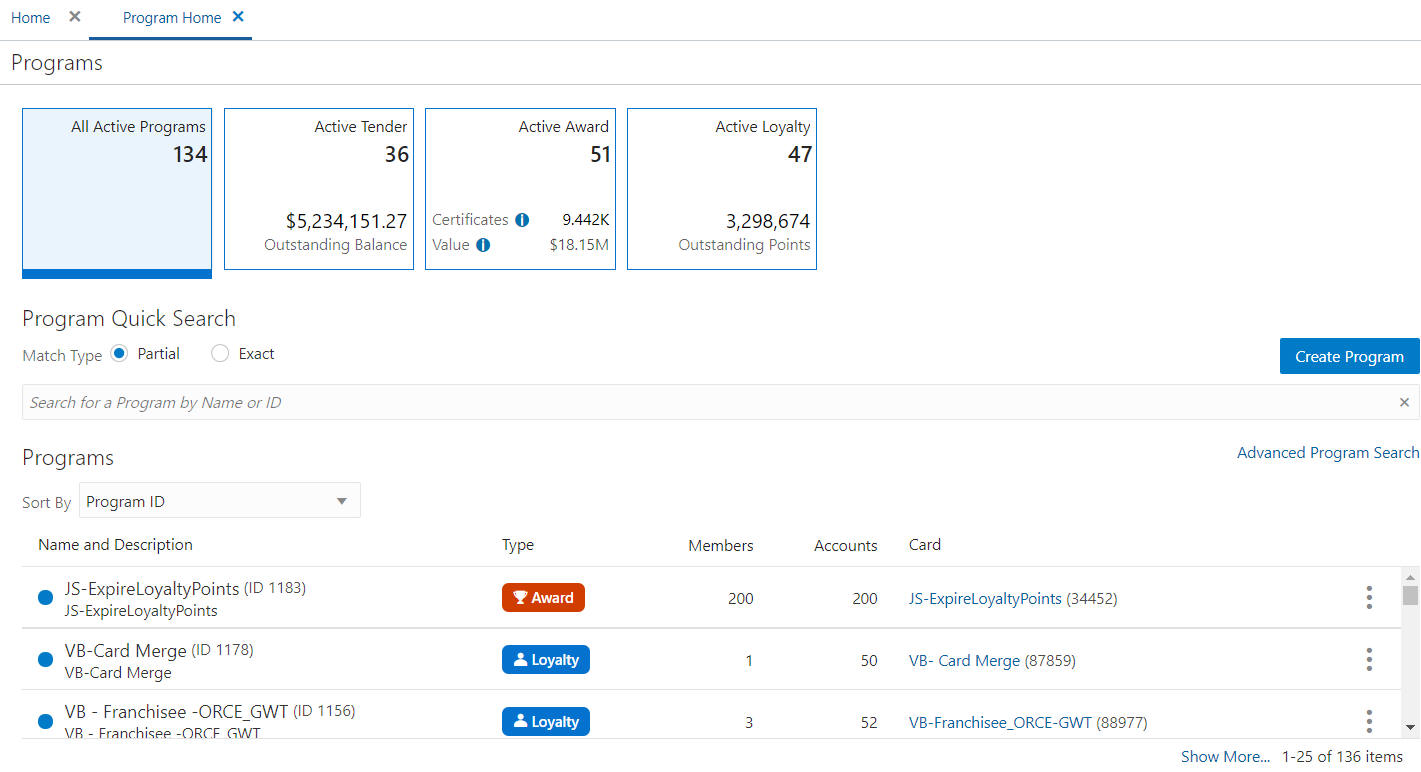
-
Select a Metric Tile, options include:
-
All Active Programs
-
Active Tender
-
Active Award
-
Active Loyalty
-
-
In the Search for Program field, enter the Name or ID of the Program you want to search for. Click Partial to search for Programs that partially match the search text, or click Exact, to search for an exact match.
Figure 10-2 Program Results
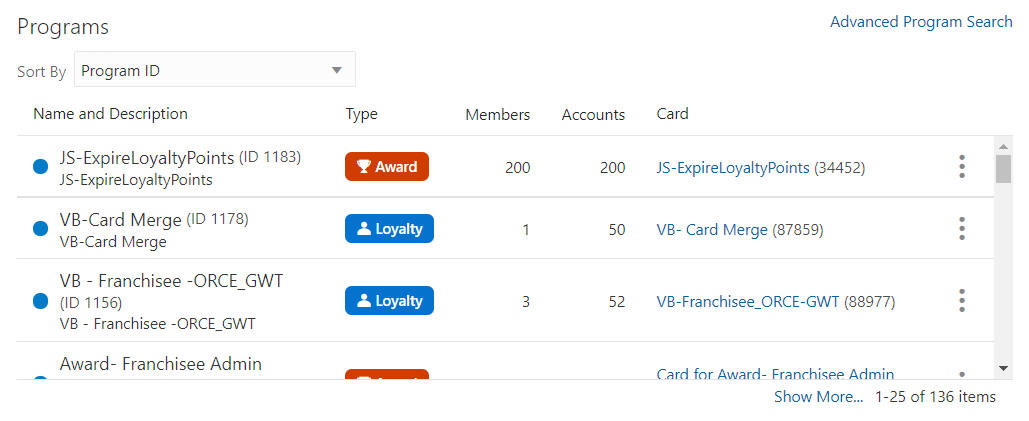
Note:
If more than 25 Programs match the search criteria, the first 25 Programs are displayed. Select Show More... at the bottom of the page to display more Programs.
The search results display the following fields:
-
Name and Description - Name and description of the program.
-
Type - Program Type
-
Members - Displays the number of registered customers in Customer Engagement.
-
Accounts - Displays the number of individual accounts created for the program. The count will include all accounts created on the card for the program. This can include registered customers, unregistered (anonymous) customers and cards that have not be issued to anyone.
-
Card - Name of Card.
-
-
Hover over any of the icons in the Name and Description column to see a tooltip listing the status of the Program as shown in Figure 10-2.
-
Active - Filled
-
Inactive - Empty
-
-
Click the Card name link for any Program to view the details. See Viewing Cards for more information. Use the Action Menu to Edit Card, Edit Program, or View Program. See Editing Cards, Editing Programs, or Viewing Programs for more information.
Figure 10-3 Action Menu Options - Program Quick Search
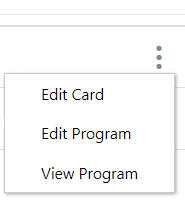
Advanced Program Search
The Advanced Program Search allows you to select more criteria that are not available in the Program Quick Search box. The Advanced Program Search is accessed by the following methods:
-
Click the Advanced Program Search link located underneath the Program Quick Search box in the Program Home window.
-
Click Program Search in the Program Task menu. See Navigation for more information.
-
Click the Program Search icon in the Quick Access Menu. See Navigation for more information.
Figure 10-4 Program Search Advanced Search Window
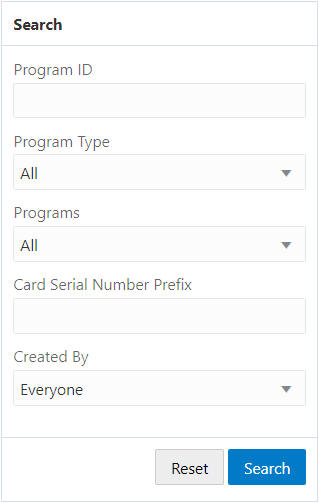
The following Search fields are available:
-
Program ID - This Text Field searches all the Progams currently present in the application. The default is an empty field.
-
Program Type - Search by Program Type. The field defaults to All.
-
All
-
Award
-
Loyalty
-
Tender
-
-
Programs - Search the Program by the status. The field defaults to All.
-
All
-
Active
-
Inactive
-
-
Card Serial Number Prefix - Your entry must be exactly five characters.
-
Created By - List of users who have created programs. The field defaults to All. Use this to search for program types a user personally created.
Searching Programs
Once all the desired information has been entered, click Search to see the results. If more than 25 results are returned, click the Show More… link to show the next 25 Programs.
Figure 10-5 Program Search Results
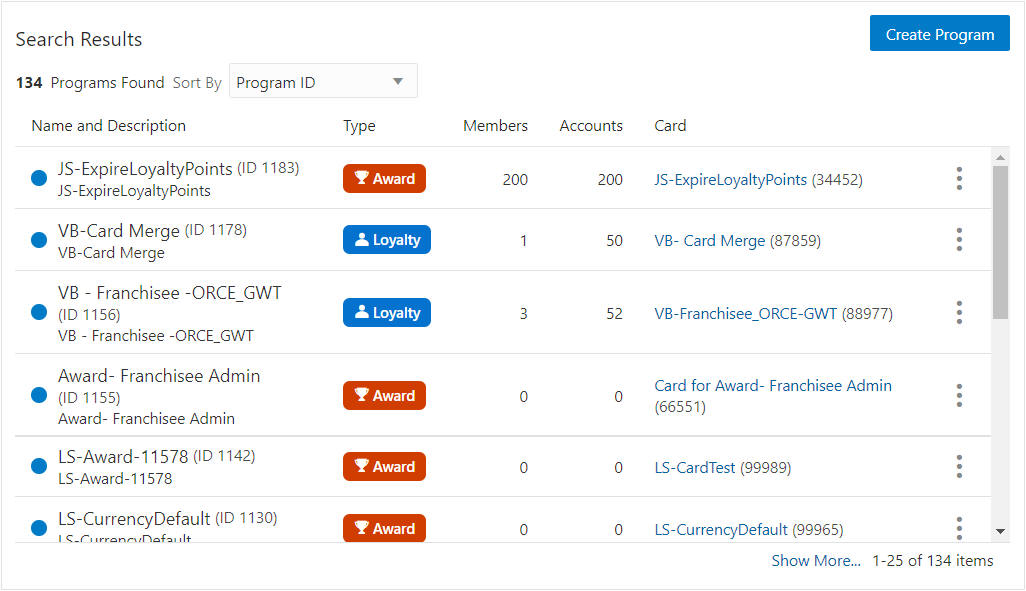
Note:
Click Reset to clear all fields and return list values to the default selections. Without entering any criteria, click Search to see a complete list of programs.
Sorting Program Results
The sort options will re-sort just the current 25 programs displayed in the window. Sorting options include:
-
Program ID - Program results are sorted by Program ID in descending order by default.
-
Program Name - Program results are sorted by Program Name in ascending order.
-
Program Type - Program results are sorted by the Program Type in ascending order
Creating a Program
There are two choices available to start the process of creating a Program. The Create Program button is available in both the Program Home window and the Program Search window.
Creating a Program - Program Search
Figure 10-6 Program Search

To Create a new program from the Program Search screen, click the Create Program button, which opens the program wizard on the Information tab. Proceed to Step 5 in Creating a Program - Program Home.
Creating a Program - Program Home
To create a new Program or Personal List from the Program Home window do the following:
-
Click the Tasks icon.
-
Click Program.
-
Click Program Home. The Tile default is All Active Programs.
Figure 10-7 Program Home

-
Click Create Program. The Create Program wizard may contain any of the following tabs, depending on configuration and the selected Program Type.
-
Information
-
Franchisees
-
Tender Program
-
Account Details
-
Award Program
-
Award Rules (Award Program)
-
Loyalty Program
-
Levels
-
Issue Rules
-
Award Rules (Loyalty Program)
-
Movement Rules
-
Card Definition
-
Card Series
-
Attributes
-
Review
-
-
Enter the following items for the Information Tab:
Figure 10-8 Information Tab

Note:
The read-only Program Information Panel displays details throughout most of the tabs of the wizard.
-
Program Type - Select the type of Program from the available options:
-
Tender Program - Tender programs represent a specific corporate liability with intrinsic value that can be exchanged for merchandise.
Note:
When Tender Program is selected, the screen displays cards that do not already have a tender program.
-
Loyalty Program - Loyalty programs accumulate points issued for purchase activities or marketing engagements. Accumulated points can be converted into various awards including coupons, E-awards and Award Certificates.
-
Award Program - Award programs contain certificates for monetary rewards known as E-awards and merchandise discounts referred to as Award Certificates.
-
-
Assign To Card
-
-
Proceed to the step based on the type of program and card configuration chosen in the previous step.
-
If the Program Type is Tender, and you are creating a new card, click Next to proceed to Step 7 the Franchisees tab.
-
If the Program Type is Tender, and you are assigning an existing card, proceed to Step 10 the Tender Program tab.
-
If the Program Type is Loyalty, and you are creating a new card, click Next to proceed to Step 7 the Franchisees tab.
-
If the Program Type is Loyalty, and you are assigning an existing card, proceed to Step 13 the Loyalty Program.
-
If the Program Type is Award, and you are creating a new card, click Next to proceed to Step 7 the Franchisees tab.
-
If the Program Type is Award, and you are assigning an existing card, proceed to Step 15 the Award Program tab.
-
-
The Franchisees tab allows you to add or change the Franchisees you wish to assign to the program.
Note:
The Franchisee tab is only visible if the
EnableFranchiseSupportconfiguration is enabled, and Franchisees are defined. If you are assigned specific franchisees, then only those franchisees you are associated with are shown.-
If Franchisees are enabled in Customer Engagement, the Franchisees Tab appears. Proceed to Step 8.
-
If Franchisees are not enabled in Customer Engagement and the Program Type is Tender, the Tender Program tab appears. Proceed to Step 10.
-
If Franchisees are not enabled in Customer Engagement and the Program Type is Loyalty, the Loyalty Program tab appears. Proceed to Step 13.
-
If Franchisees are not enabled in Customer Engagement and the Program Type is Award, the Award Program tab appears. Proceed to Step 15.
Figure 10-9 Franchisee Tab
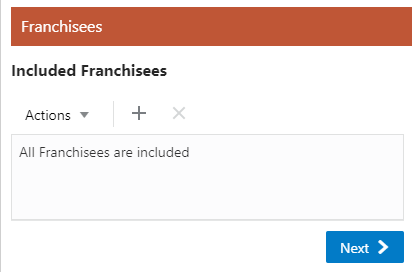
-
-
To assign a Franchisee:
-
Assigning a Franchisee
-
Either click the Action Menu and then click Assign; or click Add (+). This opens the Assign Franchisee window.
Figure 10-10 Assign Franchisee
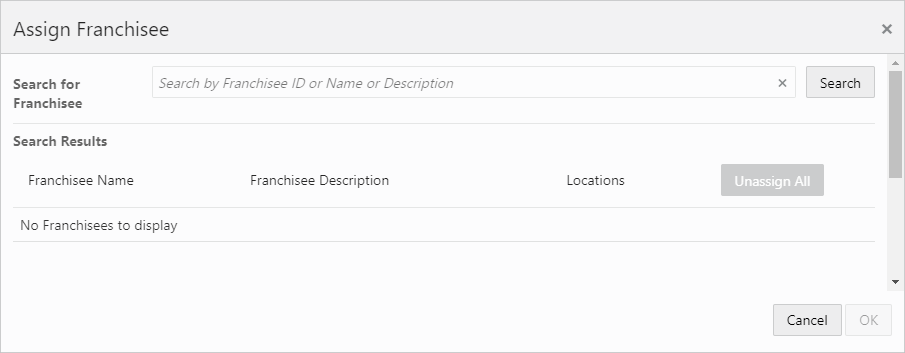
-
By default, all franchisees are assigned to the program. To make changes to those assignments, you can search for specific franchisees by entering all or part the franchisee Name, ID, or Description. Click Search in the Search for Franchisee search box.
Note:
You also have the option to enter no search criteria and click Search to retrieve all available franchisees from which to select for assignment.
-
In the Included Franchisees results list, click Assign All to assign all the search results, or click Assign for a specific franchisee to add to the program.
-
Click OK to accept the changes or Cancel to close the window without saving.
Note:
A confirmation notification appears to confirm the Franchisees has been assigned.
After a Franchisee is assigned, it appears at the top of the list. The rest of the Franchisees are ordered by ID.
Figure 10-11 Confirmation Notification

Card Administration Field
This field (unique to Programs) determines whether the franchisee will have Card Administrator privileges for the Card Definition. Select the Card Administration check box to enable Card Administrator privileges.
Figure 10-12 Card Administration Field

-
-
Unassigning a Franchisee
There are two ways to unassign any of the assigned franchisees on the program.
-
In the Assign Franchisee window, click Unassign on any Franchisees currently assigned to the program. Click OK to accept the changes or Cancel to close the window without saving.
-
To unassign Franchisees listed in the Included Franchisees table on the Franchisees tab, first highlight the row and then select the Action Menu. Either click Unassign or click X to remove the associated Franchisee.
Figure 10-13 Assign Franchisee (Using the Unassign Button)
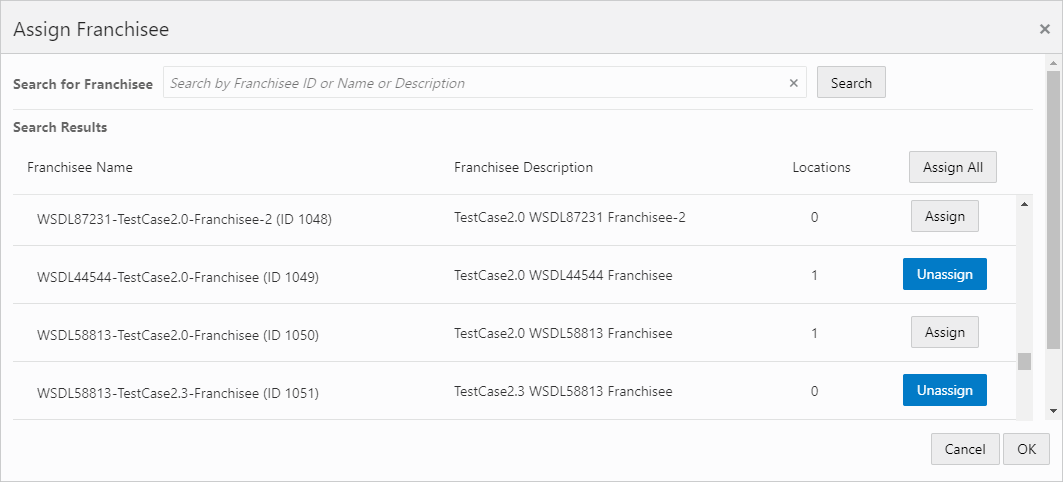
Note:
A confirmation notification appears to confirm that the Franchisees are deleted.
Figure 10-14 Confirmation Notification

-
-
-
When finished selecting the franchises on the Franchisee tab, click Next to continue to the next tab.
Note:
Before you save the Program, you can use the tab links along with Previous and Next to go back to any point in the create program process and make changes.
-
Enter the following information for the Tender Program tab:
Figure 10-15 Tender Program Tab
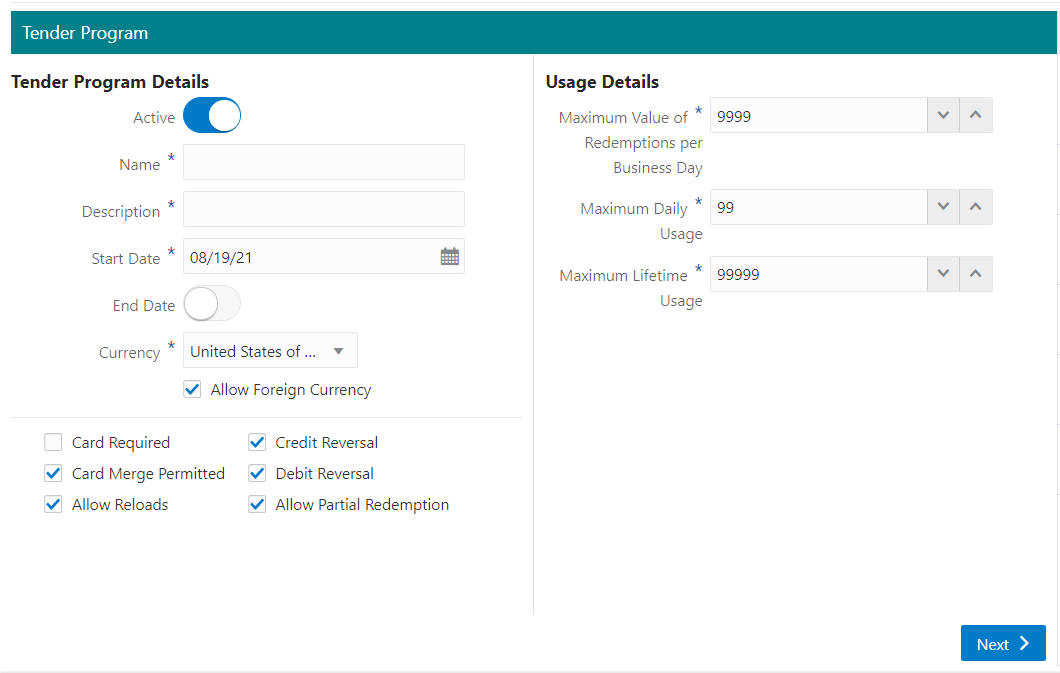
-
Tender Program Details
-
Active - Toggle on to activate the program immediately on the Start Date.
-
Name - Name of the Program.
-
Description - Description of the Program.
-
Start Date - Date on which the Program starts.
-
End Date - Toggle on to activate the Ends On date selector.
-
Ends On (displays when the End Date toggle is on) - Date on which the Program ends.
-
Currency - The base currency for the Program.
-
Allow Foreign Currency - Indicates whether foreign currency transactions (that is, a transaction performed in a currency other than the base currency) are applied to the Program.
-
Card Required - Indicates whether the customer must have the physical card present during the transaction to receive credit for the transaction.
-
Card Merge Permitted - Indicates whether the Card can be merged with another Card.
-
Allow Reloads - Indicates whether the Program allows accounts to be reloaded.
-
Credit Reversal - Indicate whether credit reversals can be performed.
-
Debit Reversal - Indicate whether debit reversals can be performed.
-
Allow Partial Redemption - Indicates whether a balance on a Tender Account can be partially redeemed.
-
-
Usage Details
-
Maximum Value of Redemptions per Business Day - The total amount of all redemptions that can be performed on a Tender Account in one day.
-
Maximum Daily Usage - The total number of times that a Tender Account can be used in one day.
-
Maximum Lifetime Usage - The total number of times that a Tender Account can be used over the lifetime of the account.
-
-
-
When finished entering the information on the Tender Program tab, click Next, then proceed to the Account Details tab.
-
Enter the following for the Account Details tab.
Figure 10-16 Tender Program - Account Details
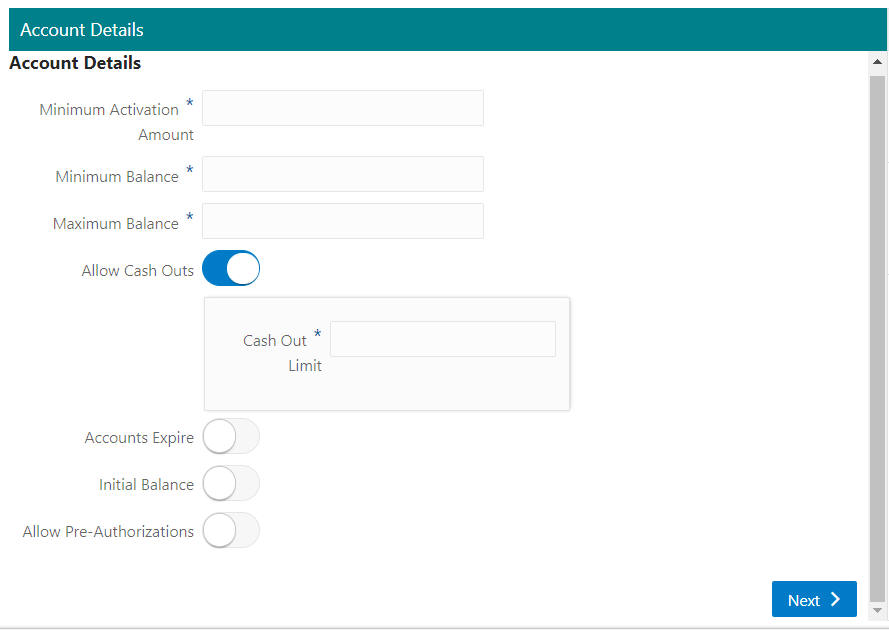
-
Minimum Activation Amount - The minimum amount that can be in an Account for it to be activated.
-
Minimum Balance - The minimum amount that must be kept in an Account.
-
Maximum Balance - The maximum amount that can be put into the Account
-
Allow Cash Outs -Toggle to on to indicate whether the account can be redeemed for cash or an equivalent tender.
-
Cash Out Limit - If cash out transactions are allowed, the maximum amount that can be cashed out in a transaction.
-
-
Accounts Expire - Toggle to on to indicate the account expires after a certain period of time.
-
Expire After - Enter the number of periods (from Period Type) that passes before a Tender Account expires.
-
Period Type - Indicates the type of period used for the Expire After field.
-
-
Initial Balance - Toggle to on to indicate there is an initial balance on each account. Enter the following:
-
Initial Balance Amount - The amount of the initial balance.
-
Initial Book Value - The initial book value of the account.
-
-
Allow Pre-Authorizations - Toggle to on to indicate that pre-authorizations are allowed for the Tender Accounts.
-
Pre-Authorizations Expire - Toggle to on to indicate that the pre-authorizations expire.
Expire After - Enter the number of periods (from Period Type) that will pass before a Tender Account expires.
Period Type - Indicates the type of period used for the Expire After field.
-
-
-
Enter the following for the Loyalty Program tab.
Figure 10-17 Loyalty Program Tab
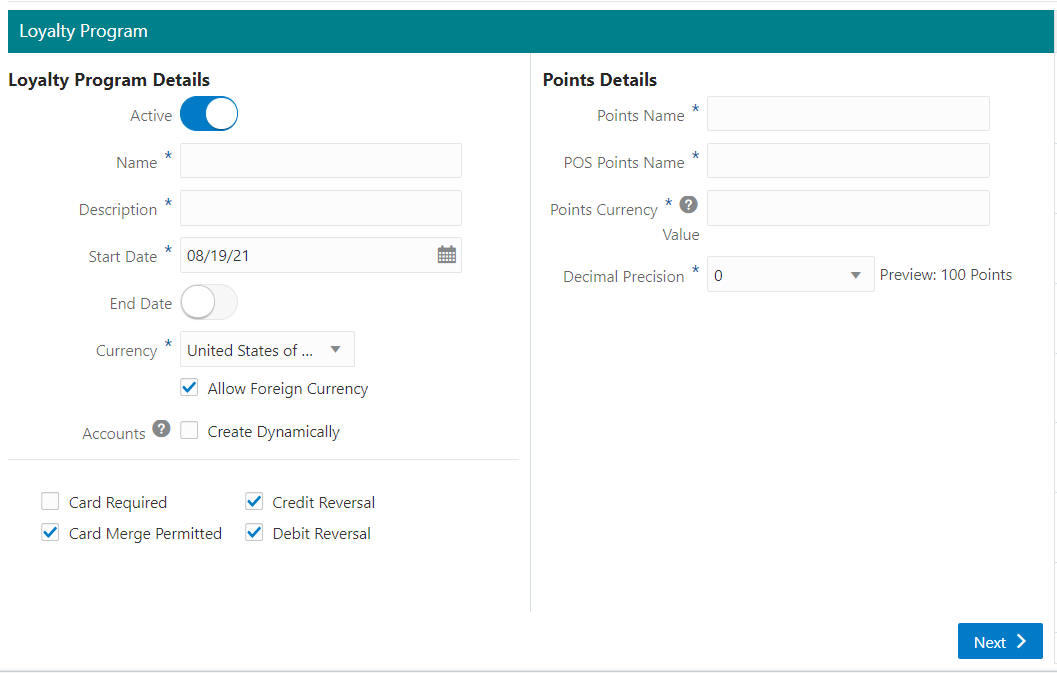
-
Loyalty Program Details
-
Active - Toggle on to activate the program immediately on the Start Date.
-
Name - Name of the Program.
-
Description - Description of the Program.
-
Start Date - Date on which the Program starts.
-
End Date - Toggle on to activate the Ends On date selector.
-
Ends On (displays when the End Date toggle is on) - Date on which the Program ends.
-
Currency - The base currency for the Program.
-
Accounts - If the check box is selected, then, a loyalty account for a card is not created until there is a POS transaction added to the card. If the check box is clear, then, the loyalty account is created when the card is generated.
-
Allow Foreign Currency - Indicates whether or not foreign currency transactions (that is, a transaction performed in a currency other than the base currency) are applied to the Program.
-
Card Required - Indicates whether or not the customer must have the physical card present during the transaction to receive credit for the transaction.
-
Card Merge Permitted - Indicates whether or not the Card can be merged with another Card.
-
Credit Reversal - Indicate whether or not credit reversals can be performed.
-
Debit Reversal - Indicate whether or not debit reversals can be performed.
-
-
Points Details
-
Points Name - Name of the points used by the Program.
-
POS Points Name - Name of the points displayed on the point of sale system.
-
Points Currency Value - Informational and reporting use only.
-
Points Decimal Precision - The number of decimal points used in tracking points.
-
Figure 10-18 Loyalty Program Tab

-
-
When finished entering the information on the Loyalty Program tab, click Next, then proceed to Step 20, the Levels tab.
-
Enter the following for the Award Program tab.
Figure 10-19 Award Program Tab
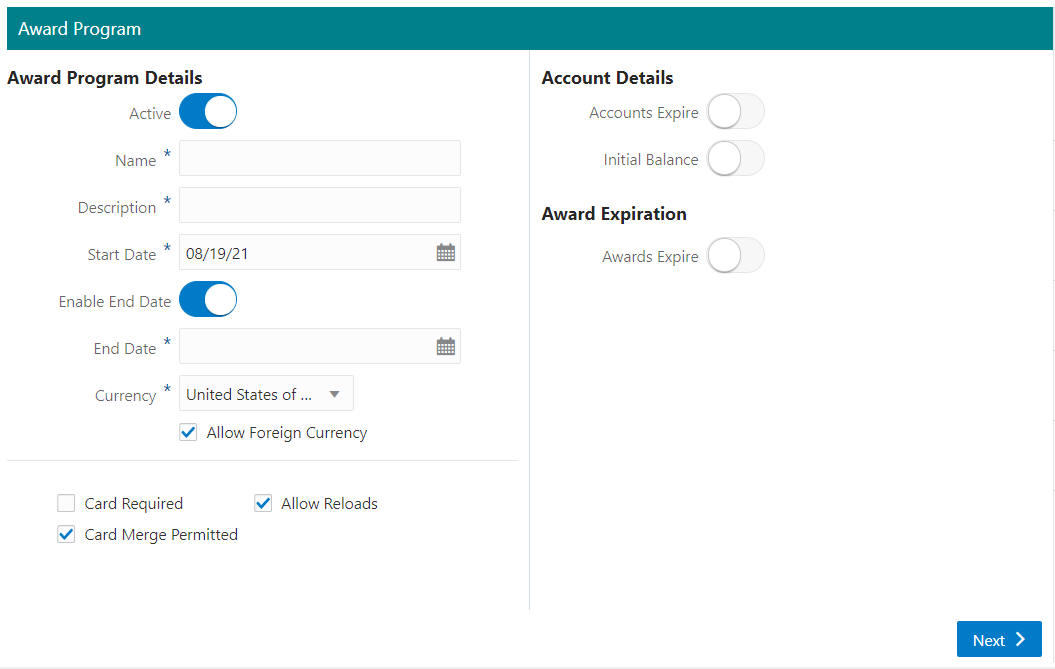
Award Program Details
-
Active - Toggle on to activate the program immediately on the Start Date.
-
Name - Name of the Program.
-
Description - Description of the Program.
-
Start Date - Date on which the Program starts.
-
Enable End Date - Toggle on to activate the Ends On date selector.
-
End Date (displays when the Enable End Date toggle is on) - Date on which the Program ends.
-
Currency - The base currency for the Program.
-
Allow Foreign Currency - Indicates whether or not foreign currency transactions (that is, a transaction performed in a currency other than the base currency) are applied to the Program.
-
Card Required - Indicates whether the customer must have the physical card present during the transaction to receive credit for the transaction.
-
Card Merge Permitted - Indicates whether or not the Card can be merged with another Card.
-
Allow Reloads - Indicates whether or not the Program allows accounts to be reloaded.
Note:
The account balance for an award account holds the value of any e-awards added to an award program. If the Allow Reloads is not checked, once the initial value is used up, the program cannot add more value to the account balance. If it is checked, E Award values can continue to be added. E Awards are created and issued from loyalty programs but the value is held in a linked award program.
Account Details
-
Accounts Expire - Toggle on to enter the preferred time period for the account to expire.
-
Initial Balance - This initial balance will hold a currency value that will be added automatically to an award account when it is activated on an individual card. This currency value can be used in the retail location toward a purchase.
Award Expiration
-
Award Expire - Toggle on to enter the preferred time and period for the award to expire.
-
Extend Expiration based on Activity (appears only when Awards Expire is toggled to on) - If the check box is clear, then the expiration date is fixed and determined by the date the coupon is issued. If the check box is selected, the expiration date is initially determined by the date the coupon is issued, but is then recalculated based on the current activity date as a courtesy to the customer when they are shopping with your company.
Note:
Before you save the Program, you can use the tab links along with Previous and Next to go back to any point in the create program process and make changes.
-
-
When finished configuring the Award Program, Click Next. Proceed to Award Rules tab.
-
Enter the following for the Award Rules tab:
Note:
The Award Rules tab in the Award Program allows the user to create an award certificate and assign time and or location rules to limit when and or where they can be redeemed.
-
Click the + Add Award Certificate button.
Figure 10-20 Add Award Certificate
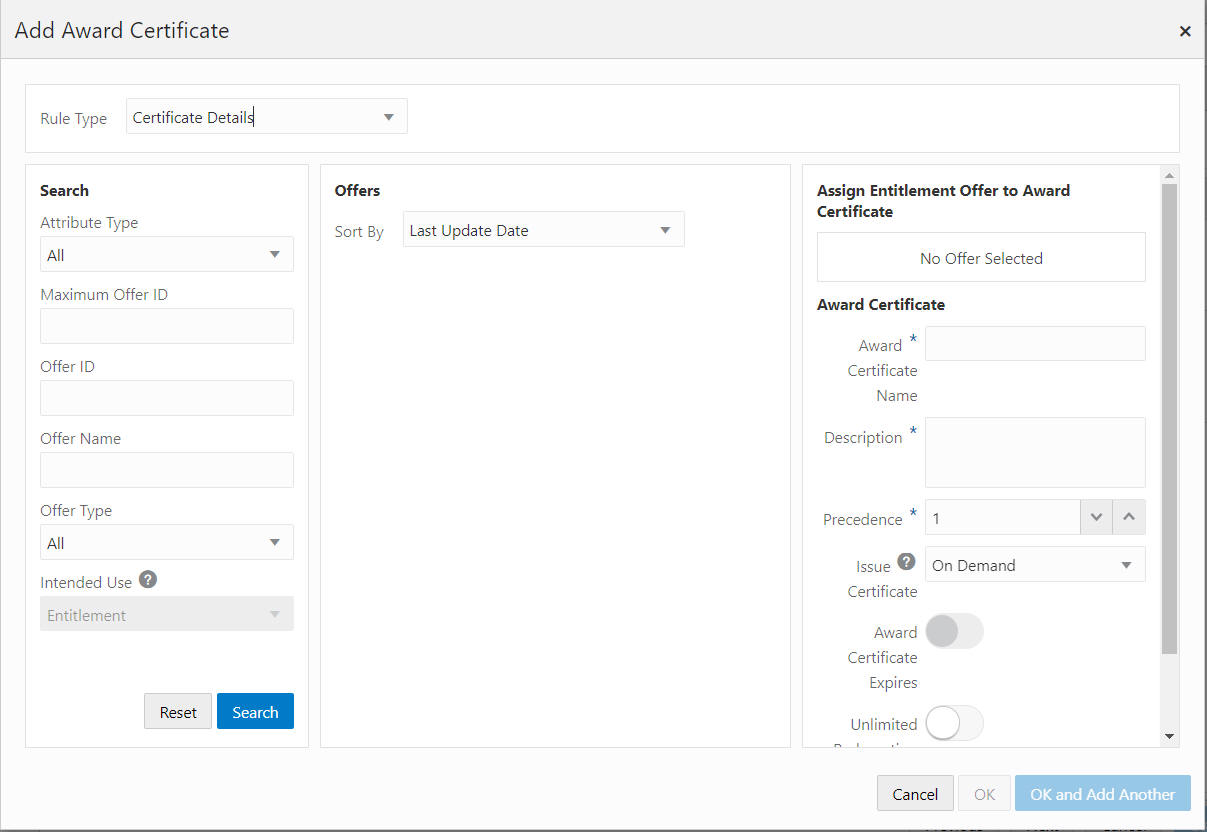
The Award Rules tab for the Award Program defaults the to Rule Type, Certificate Details. After the Offer is added to the Assign Entitlement Offer to Award Certificate, you are able to add additional Rule Types to this Award Certificate.
There are four sections; Search, Offers, Assign Entitlement Offer to Award Certificate, and Award Certificate.
-
Search - Use this section to populate the Offers Section. Fields include:
-
Attribute Type
-
Maximum Offer ID
-
Offer ID
-
Offer Name
-
Offer Type
-
Intended Use
Note:
The Intended Use field is disabled and uses the default value of Entitlement. Only offers with an Intended Use of Entitlement can be assigned to an award certificate.
-
-
Click Search to populate the Offers Section. Click Reset to clear all Search fields.
-
Sort By - Select an option to sort by the following:
-
Last Update Date
-
Offer ID
-
Offer Name
-
Offer Type
-
-
Click Add to populate the Assign Entitlement Offer to Award Certificate section.
Assign Entitlement Offer to Award Certificate
-
Click Remove to remove an offer. Return to the Offers section to select a new offer to assign.
Award Certificate
-
Enter the Award Certificate Name.
-
Enter the Description.
-
Enter the Precedence (Order in which the Award Rule will be applied if more than one Award Rule is effective).
-
Select Issue Certificate setting.
-
On Demand
-
When Account is First Activated
-
When Card is Registered to Customer
Note:
When the On Demand option is selected, the award certificate can be issued manually, by a web service or by a loyalty issue rule using the Create Loyalty Award batch.
-
-
Award Certificate Expires - This is a toggle switch, but it is read only. It is on or off based on the Issue Certificate setting. When Issue Certificate = On Demand, this toggle is Off. The expiration date is controlled by the web service or loyalty issue rule. When Issue Certificate is NOT On Demand, then the toggle is On (read only) and the user is required to select expiration parameters.
-
To allow unlimited redemptions, toggle on Unlimited Redemption.
-
When the Unlimited Redemption toggle is off, enter the number of Maximum Redemptions allowed.
Rule Types - These are the eligibility rules that will be used to determine when the award certificate is effective.
Note:
The next section deals with the Rule Types available for the Award Certificate once an Entitlement Offer is assigned. Any of the Rule Types can be combined with other Rule Types.
Time Rule - Defines the time rules when the award certificate is effective.
-
Enable Time Rule - Toggle on to activate the Time Rule Name, Description, and Time Rule Type fields, and the purpose is to define when the award certificate is effective. If it is turned off, the award certificate has no restrictions as to when it is effective.
-
Time Rule Name - Name of the Time Rule.
-
Description - Description of the Time Rule.
-
Time Rule Type - Types include:
-
Eligibility Period
-
Blackout Period
Figure 10-21 Time Rule - Eligibility Period / Blackout Period
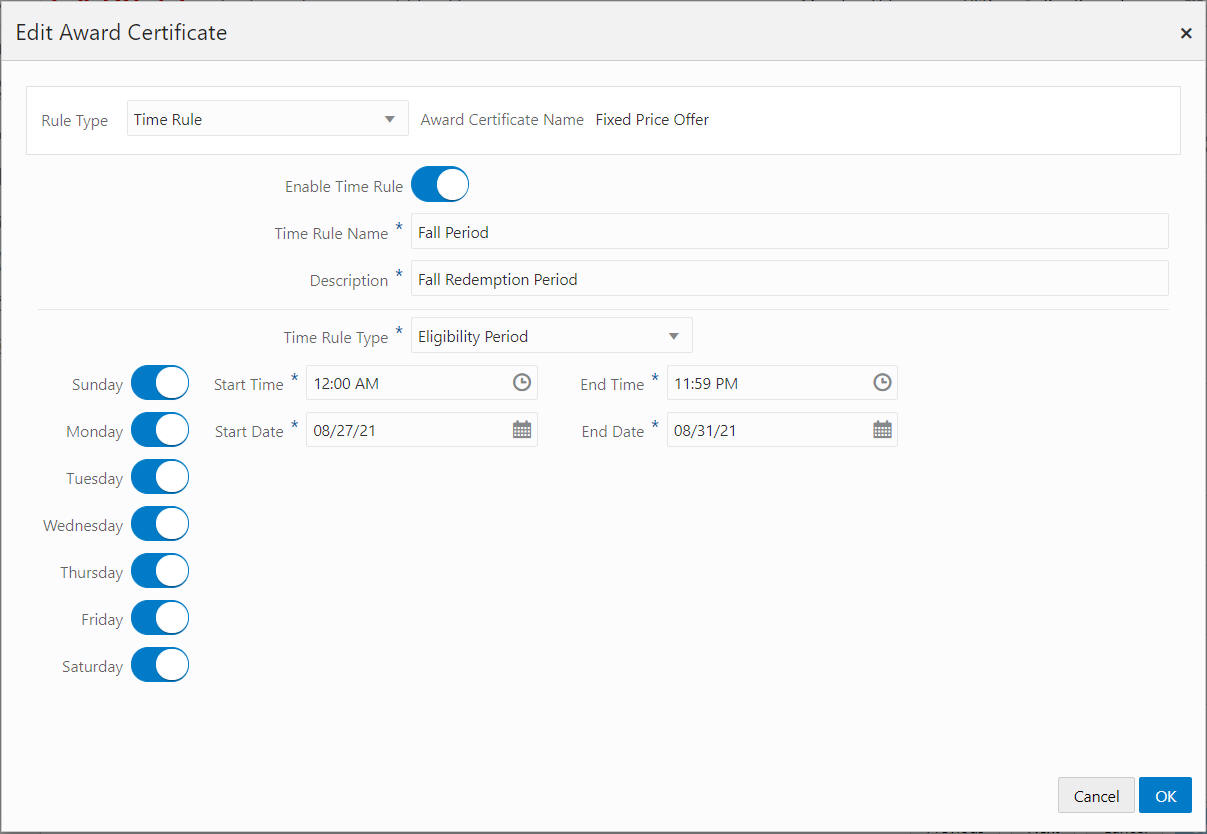
-
-
Toggle on to select each day of the week for which the time rules apply for this Item Rule.
-
Enter a Start Time.
-
Enter an End Time.
-
Enter a Start Date.
-
Enter an End Date.
Location Rule (Include) or Location Rule (Exclude)
Defines which locations the award certificate is effective in, or which locations are excluded. Both Rule Types are configured in the same way.
Figure 10-22 Location Rule (Include)
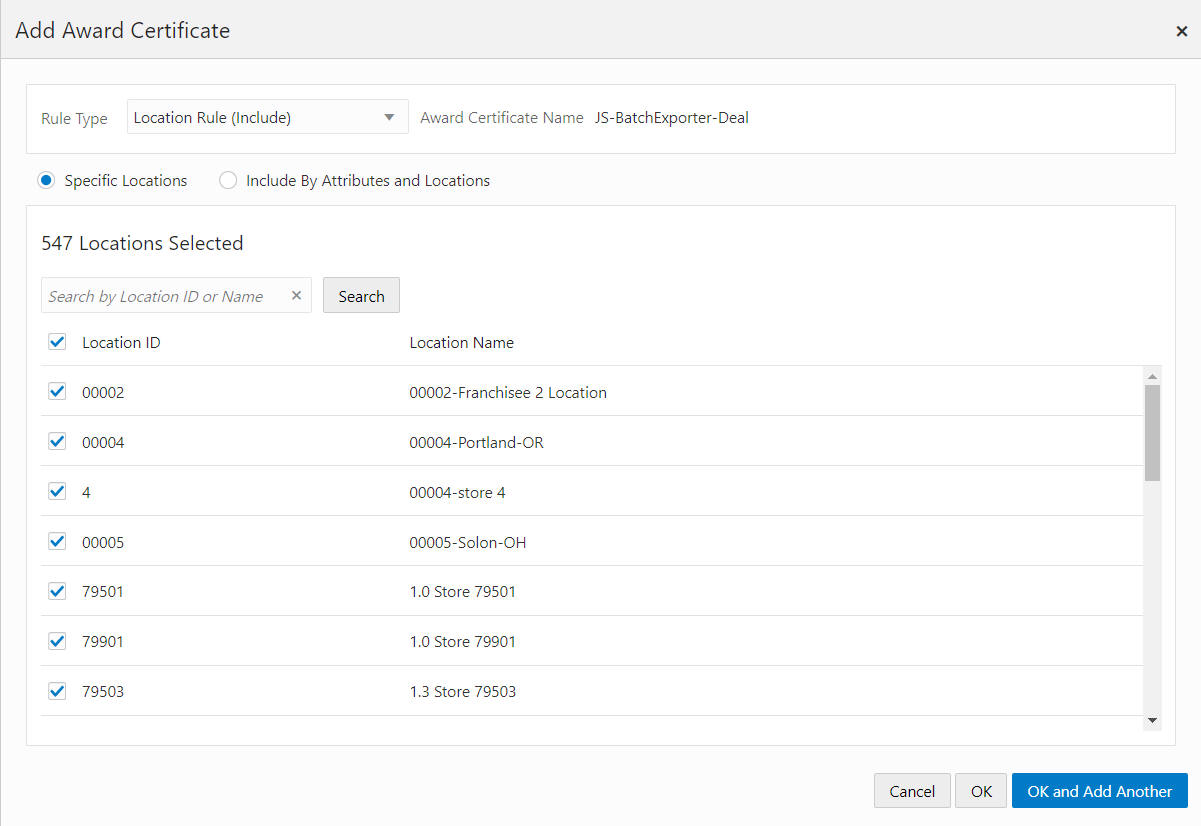
-
To add an Award certificate by Specific Locations:
Note:
The Location ID check box at the top of the list enables you to clear or select all locations. If you clear all the locations, then you can scroll through the list or search for a specific location.
-
Enter part or all of a Location ID or Name.
-
Click Search.
-
Select the check box for each of the desired Locations.
-
-
To add an Award certificate using Include By Attributes and Locations or Exclude By Attributes and Locations
-
Click Add to select an attribute. The By Attributes and By Location options can be collapsed or expanded.
-
After the initial selection, additional choices display in the query with the condition, Or (one or more of the conditions must be met). Click Or to change to And (both conditions must be met).
-
Click the Vertical Ellipsis and select Remove to clear the attribute from the query.
-
-
Click OK to add the Award Certificate to the Program or click OK and Add Another to add another Award Certificate. Click Cancel to close the window without adding the Award Certificate.
-
-
When finished entering all the Award Rules to the Award Certificates, in the Award Rules tab, click Next.
-
When finished defining Account Details do the following:
-
The Levels tab displays information for each Level in the Loyalty Program. Enter the following information to add Loyalty Levels.
Figure 10-23 Levels Tab
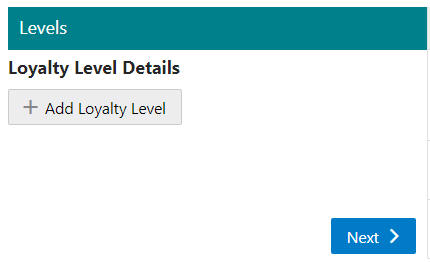
Adding Initial Loyalty Level
-
Click + Add Loyalty Level.
Loyalty Level Details
Figure 10-24 Loyalty Level Details

-
The Active toggle default is on. Click the toggle off to inactivate the Loyalty Level.
-
Enter a Level Name.
-
Enter a Description.
-
Select a Level Color.
Earning Points
Figure 10-25 Earning Points

-
Select the Negative Balance Allowed check box to indicate when the Loyalty Level allows customers to have negative point balances.
-
Age Points (toggle on to activate) - Selecting the Fixed reset type expires the entire unused points balance after the account has been inactive for x periods. Selecting the Relative reset type expires the individual unused points x periods after each has been earned. Enter the Reset After number of periods then select the type of period.
-
Escrow Points (toggle on to activate) - Determines whether points are escrowed before they become available for use as Earned Points. Enter the Escrow After number of periods then select the type of period.
-
Click OK to add the Level to the Program or click OK and Add Another to add another Level. Click Cancel to close the window without adding the Level.
Edit/Deactivate Loyalty Levels
-
Click the Additional Options ellipsis to Deactivate or Edit a Loyalty Level.
-
-
When finished entering all Loyalty Levels on the Levels tab, click Next to proceed to the Issue Rules tab.
-
The Issue Rules tab contains a Layer List of rules that determine how points are issued by the Loyalty Level. The default Rule Type is Definition.
Figure 10-26 Issue Rules Tab
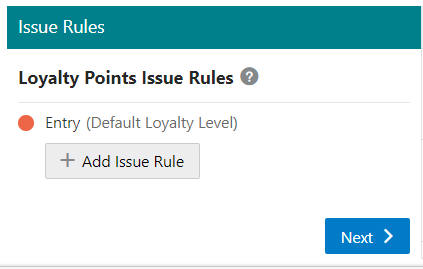
Adding an Issue Rule
-
Click + Add Issue Rule.
Note:
Issue Rules are required to use the Definition Rule Type. Once the Definition rule type has been completed and validated, you can add additional Rule Types before you click OK to save the Issue Rule. Availability of the Rule Types are determined based on the selected Calculation Type.
Issue Rule Details
Figure 10-27 Add Issue Rule to Entry
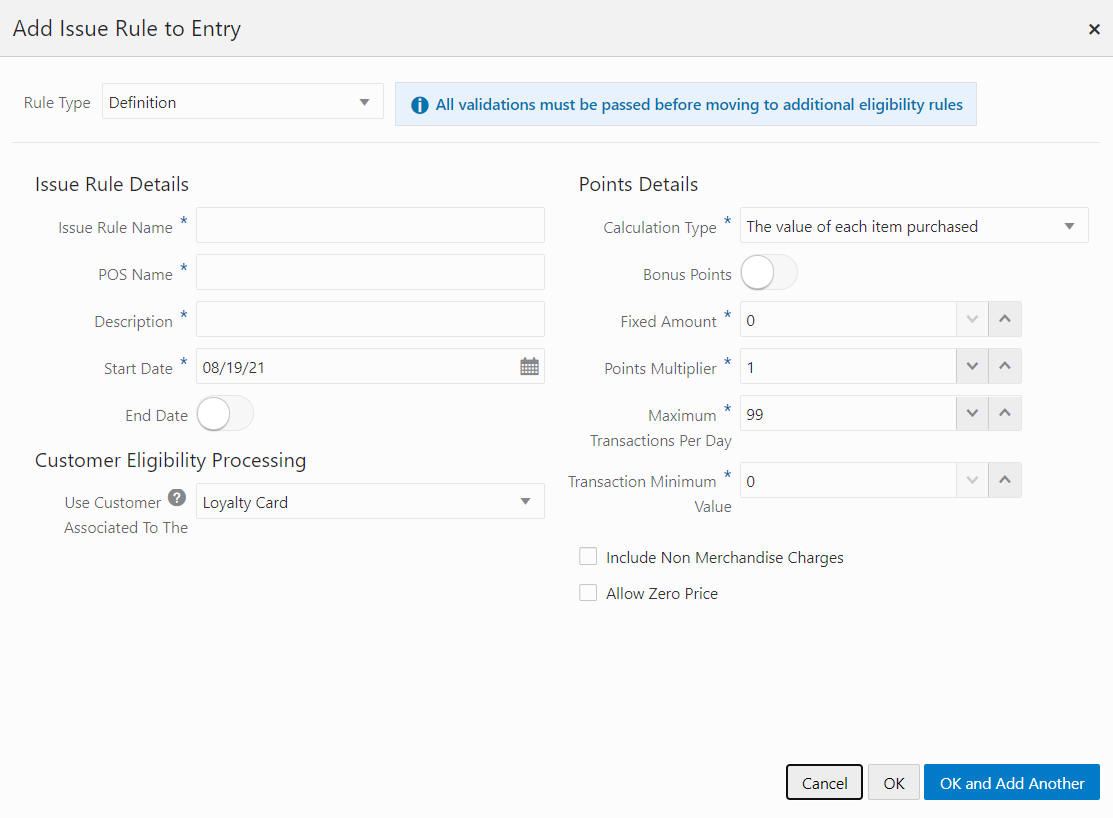
-
Use the required default Definition Rule Type.
-
Enter the Issue Rule Name.
-
Enter the POS Name.
-
Enter the Description.
-
Click the Date Selector icon to choose a Start Date or enter the date in the Start Date text box.
-
If desired, toggle off End Date to display the Ends On text box. Click the Date Selector icon to choose a Ends On date or enter the ends on date in the Ends On date text box.
Customer Eligibility Processing
-
Select the Use Customer Associated To The Loyalty Card or Transaction.
Note:
When Loyalty Card is selected, the customer associated to the card is used to evaluate audience rule eligibility. When Transaction is selected, the customer associated to the transaction is used.
Points Details
-
Calculation Type - Indicates the value that is used as the point-determination method.
-
The value of each item purchased - The sale amount of each item purchased in the transaction.
-
The quantity of each item purchased - The quantity of each item purchased in the transaction.
-
The number of marketing engagements - The number of times the customer interacts with marketing media, such as watching a video online.
-
The number of qualifying transactions - The number of qualifying transactions made by the Customer.
-
The number of qualifying visits - The number of qualifying visits made by the Customer
-
-
Bonus Points - Indicates whether this Issue Rule stipulates that the Loyalty Program issues points as Bonus Points (defaults to ON if the Calculation Type is The number of marketing engagements) or Regular Points.
-
Fixed Amount - The Fixed Amount, if any, assigned to each transaction or marketing engagement.
-
Points Multiplier - The number multiplied by the value indicated in the Calculation Type field (only shown if the selected Calculation Type is either The value of each item purchased or The quantity of each item purchased).
-
Maximum Transactions Per Day - The maximum number of sales transactions in a single day that will be used to calculate Loyalty points.
-
Transaction Minimum Value - Minimum amount of a transaction for it to be applied to a Loyalty account.
-
Include Non-Merchandise Charges - Determines whether points will be issued for non-merchandise charges in a transaction.
-
Allow Zero Price - Determines whether points will be issued for zero priced items in a transaction.
Issuance Rules - Displays when the Calculation Type is, The number of marketing engagements.
-
Frequency Period - This field determines the time period used to control the frequency with which a Customer can earn points through marketing engagements. Can be set to One-time only, Daily, Weekly, Monthly, or Yearly.
-
Issues Per Period - The number of times a Customer can earn points through marketing engagements during the Frequency Period. Set to 1 if the Frequency Period is One-time only.
-
Unlimited Issuance - Determines whether points can be issued an unlimited number of times during the Frequency Period.
-
Rule Count Limit - The total number of times a Customer can earn points through marketing engagements.
Rule Types - Rules to set limits on how and when Issue Rules are applied and used.
Note:
Availability of Rule types are based on a previously selected Calculation Type.
Note:
The next section deals with the seven Rule Types available. They can be combined within a single Issue Rule.
Time Rule - Defines the time rules when loyalty points can be issued for a loyalty program, that rewards customers when they purchase during specific hours and date ranges.
Figure 10-28 Time Rule
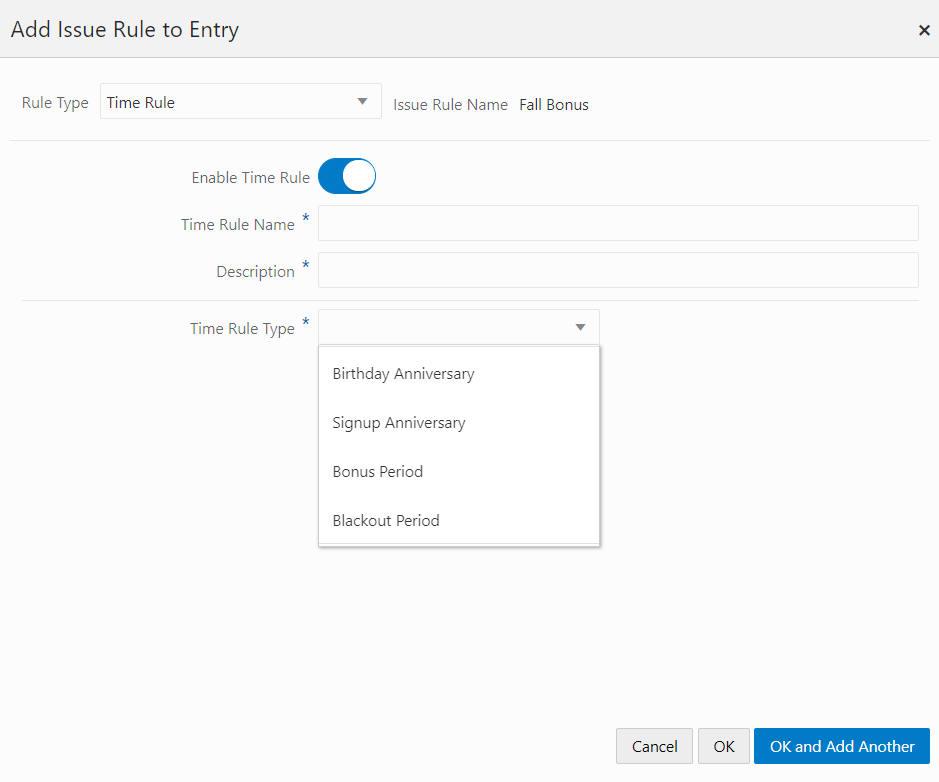
-
Enable Time Rule - Toggle to On to activate Time Rule Name, Description, and Time Rule Type fields.
Note:
This switch can be turned off after defining the rules so there are no limitations to the time the issue rule applies.
-
Time Rule Name - Name of the Time Rule.
-
Description - Description of the Time Rule.
-
Time Rule Type - Types include:
-
Birthday Anniversary
-
Signup Anniversary
-
Bonus Period
-
Blackout Period
Figure 10-29 Time Rule Type - Bonus Period/Blackout Period Options
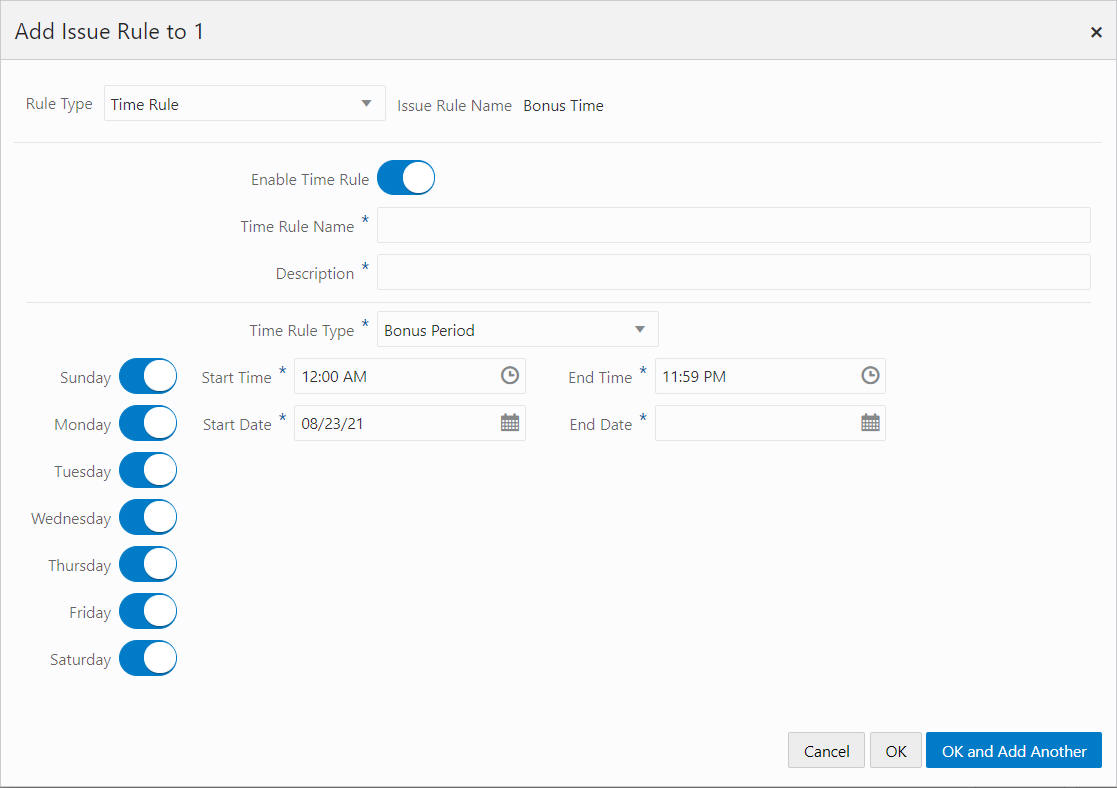
Bonus/Blackout Period Time Type Configuration
-
-
Select the Day of the Week for which the time rules will apply for this Item Rule.
-
Enter a Start Time.
-
Enter an End Time.
-
Enter a Start Date.
-
Enter an End Date.
Note:
Each Rule Type configuration is saved during the process. To configure more Rule Types, select a Rule Type from the options list. Do not click OK until all desired Rule Types are configured.
-
If no more Rule Types are desired, click OK to save, Cancel to close without saving, or click OK and Add Another to create additional Issue Rules for that Loyalty Level. Otherwise continue to configure additional Rule Types.
Item Rule (Include) or Item Rule (Exclude)
Defines which items are eligible to accrue loyalty points. Both Rule Types are configured in the same way by selecting either: Include All Items, Include By Hierarchy, or Specific Items
-
To configure a Rule Type by using Include All Items:
Figure 10-30 Item Rule (Include) - Include All Items
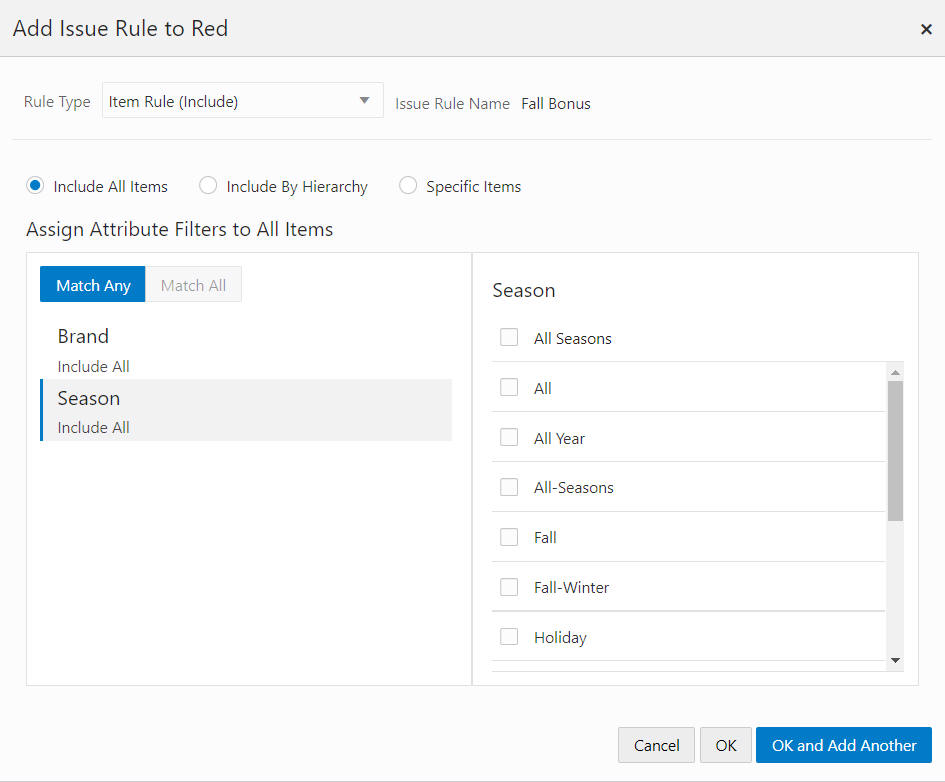
-
In the left pane, select the desired attribute filter from the list of available choices. Once selected, any associated values for the attribute appear in the right pane.
-
In the right pane, select or clear values of the selected attribute filter. You can add all values for that attribute by selecting the check mark in the top check box.
-
Repeat the process for any or all the available Attribute Filters in the left pane.
-
-
To configure a Rule Type by using Include By Hierarchy:
Figure 10-31 Item Rule (Include) - Include By Hierarchy
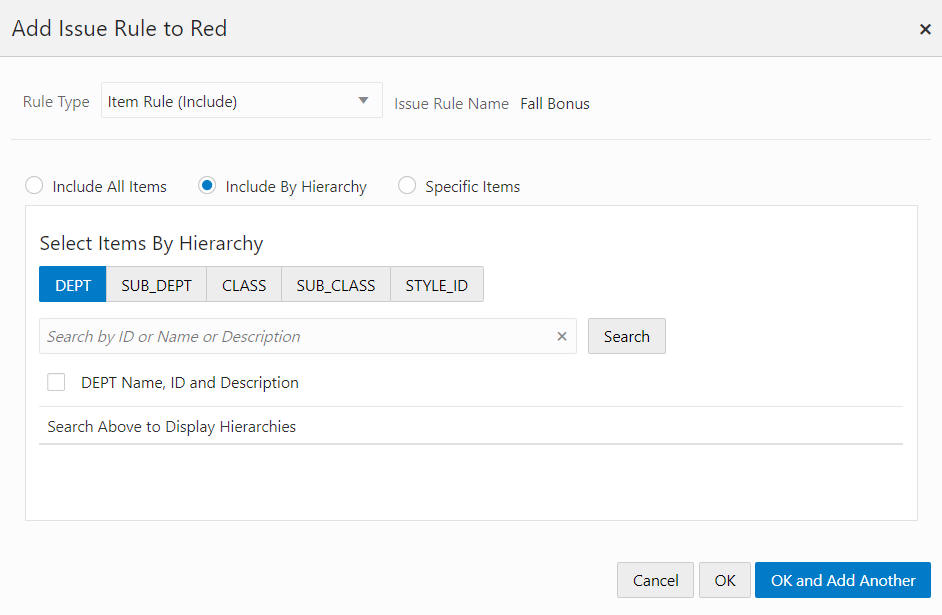
-
In the Search by ID or Name or Description field, enter any part or entire Hierarchy ID, Name, or Description.
-
Click Search.
-
Select or clear values of the selected attribute filter. You can add all values for that attribute by selecting the check mark in the top check box.
-
-
To configure a Rule Type by using Specific Items:
Figure 10-32 Item Rule (Include) - Specific Items
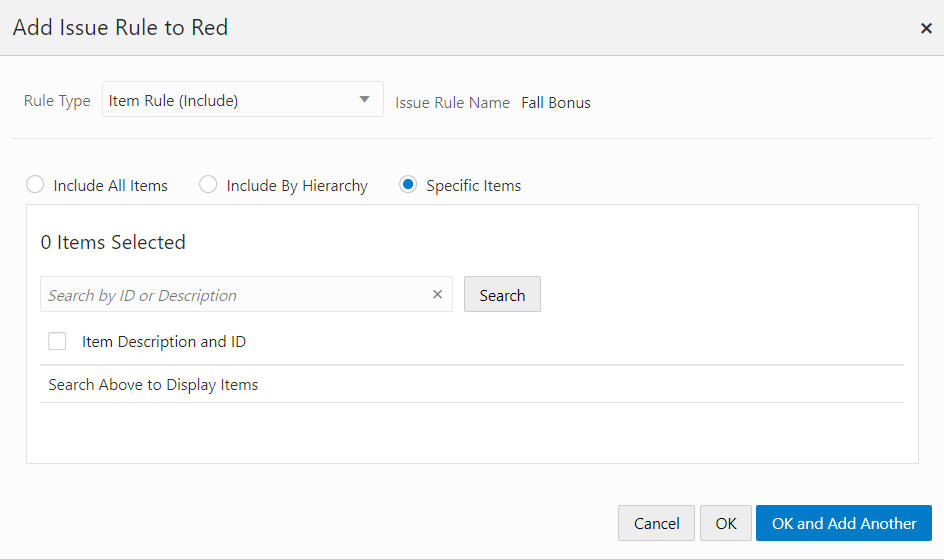
-
In the Search by ID or Description field, enter any part or entire Item ID or Description.
-
Click Search.
-
Select or clear values of the selected attribute filter. You can add all values for that attribute by selecting the check mark in the top check box.
Tender Rule
This can be used to define when the customer uses specific tender types, the customer is eligible for points to be issued.
Figure 10-33 Tender Rule
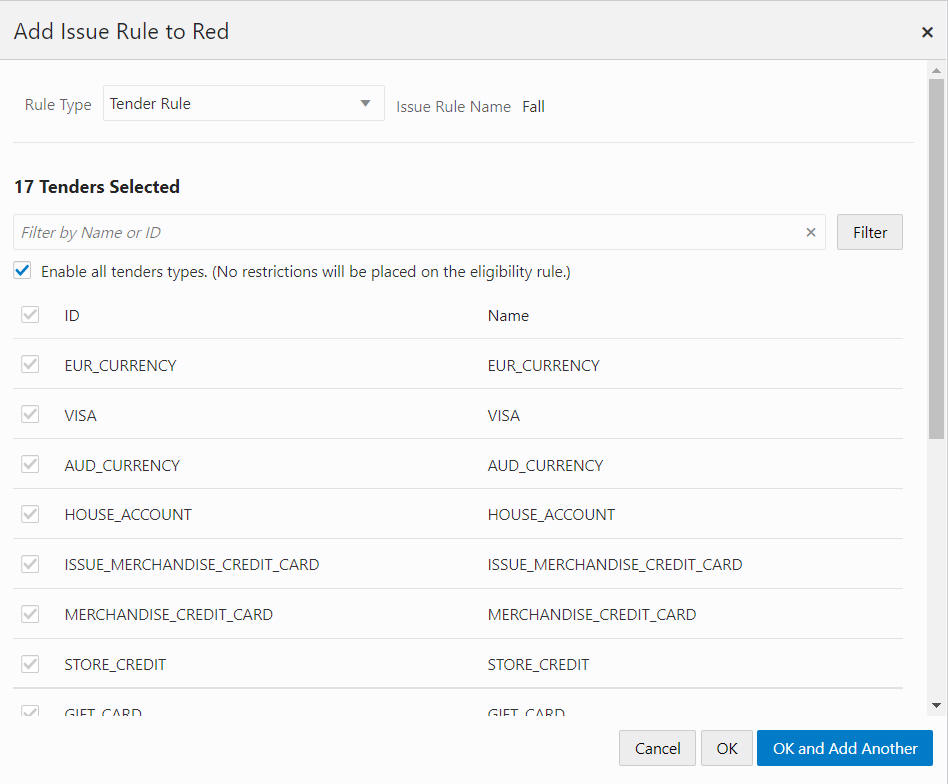
-
-
In the Filter by Name or ID field, enter any part or entire Tender Name or ID.
-
Click Filter.
-
You can clear Enable All Tender Types by clearing the check mark in the top check box. Then you can look through the list and choose specific tenders by selecting the associated check box.
Location Rule (Include) or Location Rule (Exclude)
Defines which locations are eligible to accrue loyalty points. Both Rule Types are configured in the same way.
-
Specific Locations
Figure 10-34 Location Rule (Include) - Specific Locations

Note:
The Location ID check box at the top of the list enables you to clear or select all locations. If you clear all the locations, then you can scroll through the list or search for a specific location.
-
Enter part or all of a Location ID or Name.
-
Click Search.
-
Choose specific Locations by selecting the associated check box.
OR
-
-
Include By Attributes and Locations/Exclude By Attributes and Locations
Figure 10-35 Location Rule (Include) - Include By Attributes and Locations
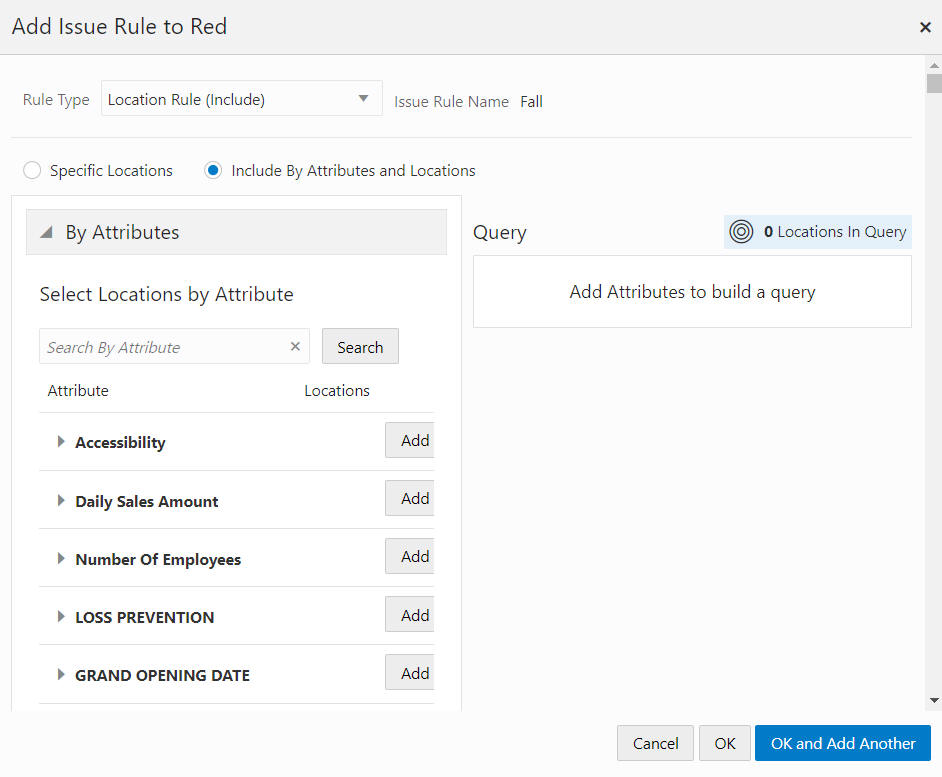
-
Click Add to select an attribute. The By Attributes and By Location options can be collapsed or expanded.
-
After the initial selection, additional choices display in the query with the condition, Or (one or more of the conditions must be met). Click Or to change to And (both conditions must be met).
-
Click the Vertical Ellipsis and select Remove to clear the attribute from the query.
Audience Rule
If an audience rule is created, only customers in the selected lists will earn points.
Figure 10-36 Audience Rule
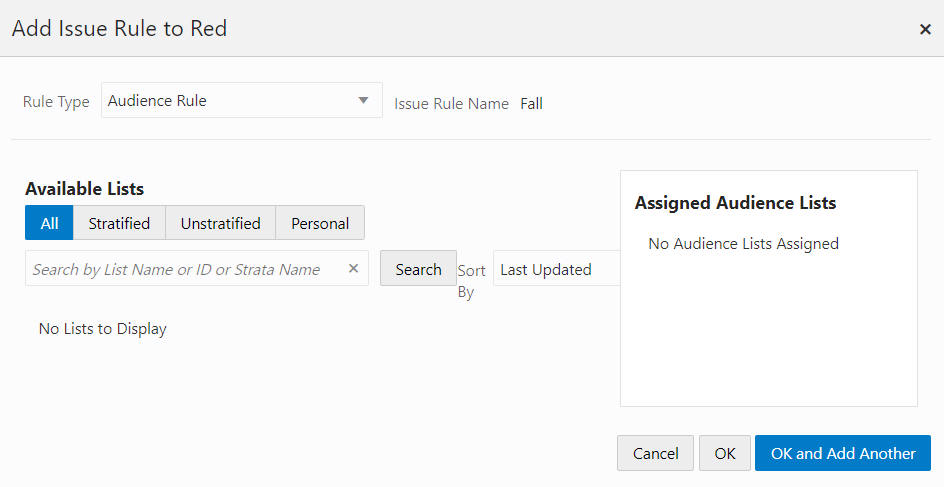
-
-
Select an Available List type.
-
All - Default
-
Stratified - The customers within a Stratified list are divided into levels.
-
Unstratified - The customers within an Unstratified list are not differentiated into separate groups.
-
Personal - customers maintained by the user.
-
-
In the Search field, enter part or all of the List Name, ID, or Strata Name.
-
Click Search. The results can be sorted by using the Sort by list menu with the following options:
-
Last Updated
-
Name
-
Customer Count
-
-
Click Add for each Available List to add the selection to the Assigned Audience Lists.
Note:
Lists with more than one group display an Expand icon. Click the Expand icon to see the available choices within that list.
Figure 10-37 Available Lists - Expand Icon
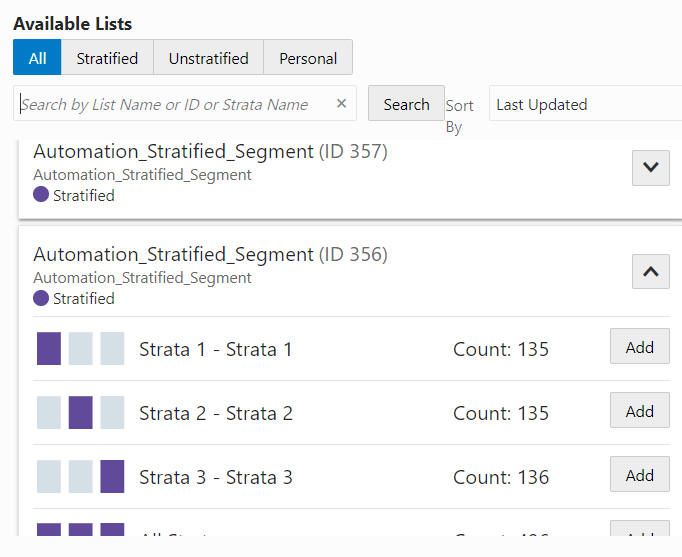
-
Click OK to save, click Cancel to close without saving, or click OK and Add Another to save the configured Rule Types and configure additional Issue Rules.
-
-
Review the Issue Review Definition area as shown in Figure 10-38. Click the Vertical Ellipsis to Edit or Remove the Issue Rule.
Figure 10-38 Issue Rule Definition
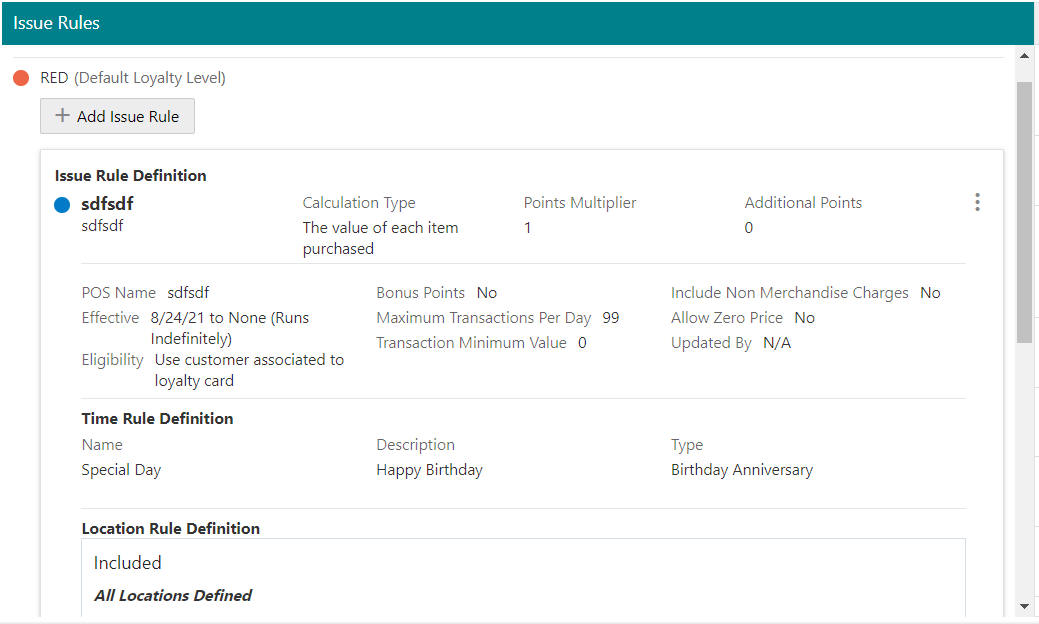
-
When finished entering all Issue Rules, click Next to go to the Award Rules tab.
-
Enter the following for the Award Rules tab. The Award Rules tab contains a Layer List of rules that determine how Coupon, E Award, or Award Certificates are issued by the Loyalty Level.
-
Click the + Add Award Rule button.
Note:
'The Award Rules Tab, in the Loyalty Program, defines what awards can be issued, when an award can be issued based on the loyalty points balance and the points cost to use the award. An award program is required to hold an Award Certificate or E-Award value. Therefore, when creating a new card, Coupon is the only available Award Type Rule, since an existing award program is not required.
-
Select an Award Rule Type (Coupon -Default) and enter the following:
Coupon
Figure 10-39 Award Rule Type - Coupon
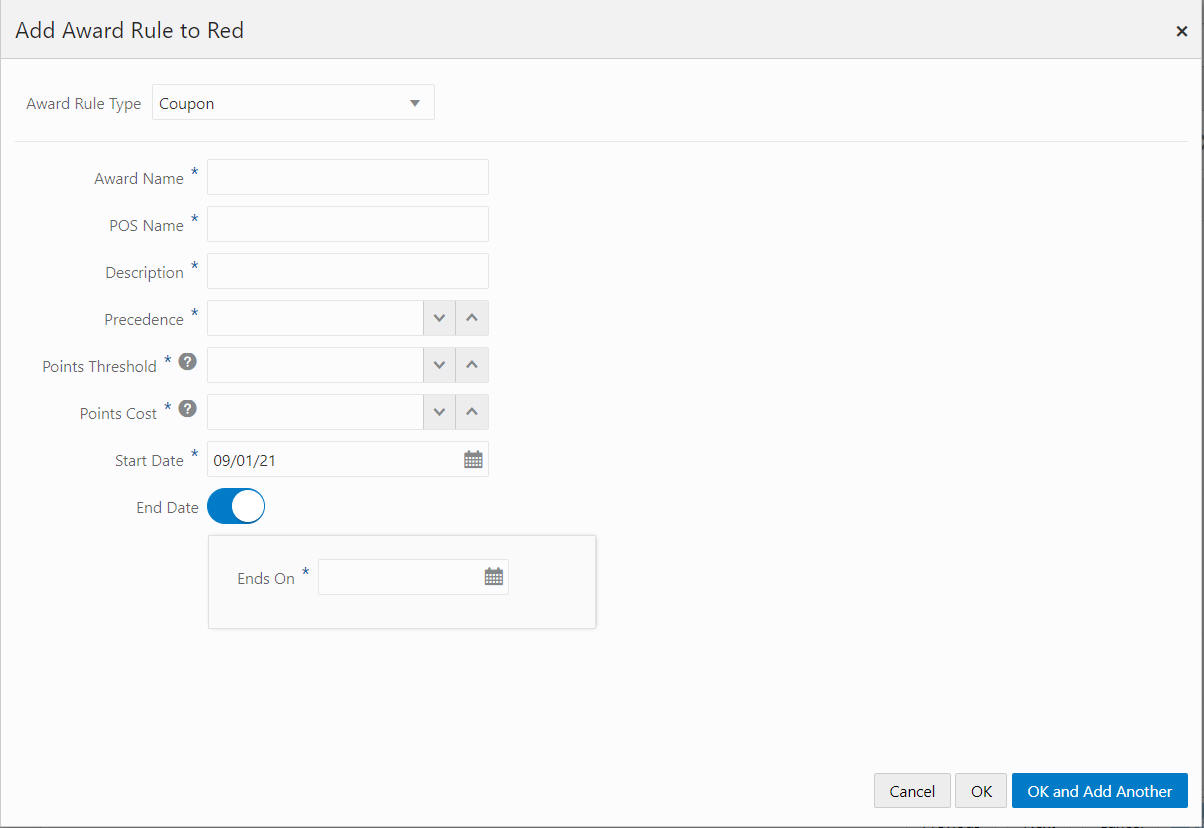
-
Award Name
-
POS Name
-
Description
-
Precedence (Order in which the Award Rule will be applied if more than one Award Rule is effective).
-
Points Threshold (The customer's loyalty account balance must be equal to or greater than the number entered in this field to issue this award).
-
Points Cost
-
Start Date
-
End Date - Toggle the End Date On to enter an End Date if desired.
E Award
Figure 10-40 Award Rule Type - E Award

Awards Rule Details
-
Enter the Points Cost Type. The fields in the Award Rules Details section for an E Award will change depending upon the value in the Points Cost Type Selection Menu
-
Fixed - E Award is a fixed amount.
-
Cashback - E Award value will depend upon the number of points in the Loyalty Account, which allows for full redemption.
-
-
Enter the Award Name.
-
Enter the POS Name.
-
Enter the Description.
-
Enter the Precedence (Order in which the Award Rule will be applied if more than one Award Rule is effective).
-
Select Issue Reward setting.
Note:
When the Issue Certificate is set to Immediately Upon Transaction Posting, the award certificate will be issued to a customer account as soon as the system processes the purchase activity. If the selection is set to When Create Loyalty Award Batch Runs, the award certificate will not be issued after the scheduled batch job runs.
-
Enter the Award Factor (Cashback only). A multiple used to convert points to an E-Award amount (in the base currency of the Award Program).
-
Reset Balance (Cashback only) - Indicates whether the loyalty points balance is reset when the Award is issued.
-
Enter the Points Threshold.
-
Enter the Start Date.
-
End Date - Toggle the End Date to On to enter an End Date if desired.
E Award Details
-
Select an Award Program.
Note:
The list will display the award programs already on the selected card
-
Enter the Award Amount.
-
Enter the Minimum Award Amount (Cashback only).
-
Enter the Coupon Prefix.
-
Award Expire - Toggle on to configure expiry settings.
-
Select Expiration Type.
Relative - Enter the Expires After value and select a Time Period.
Program - E Award will use the Award Expiration defined for the award program the E Award will be held in.
Award Certificate
Figure 10-41 Award Rule Type - Award Certificate
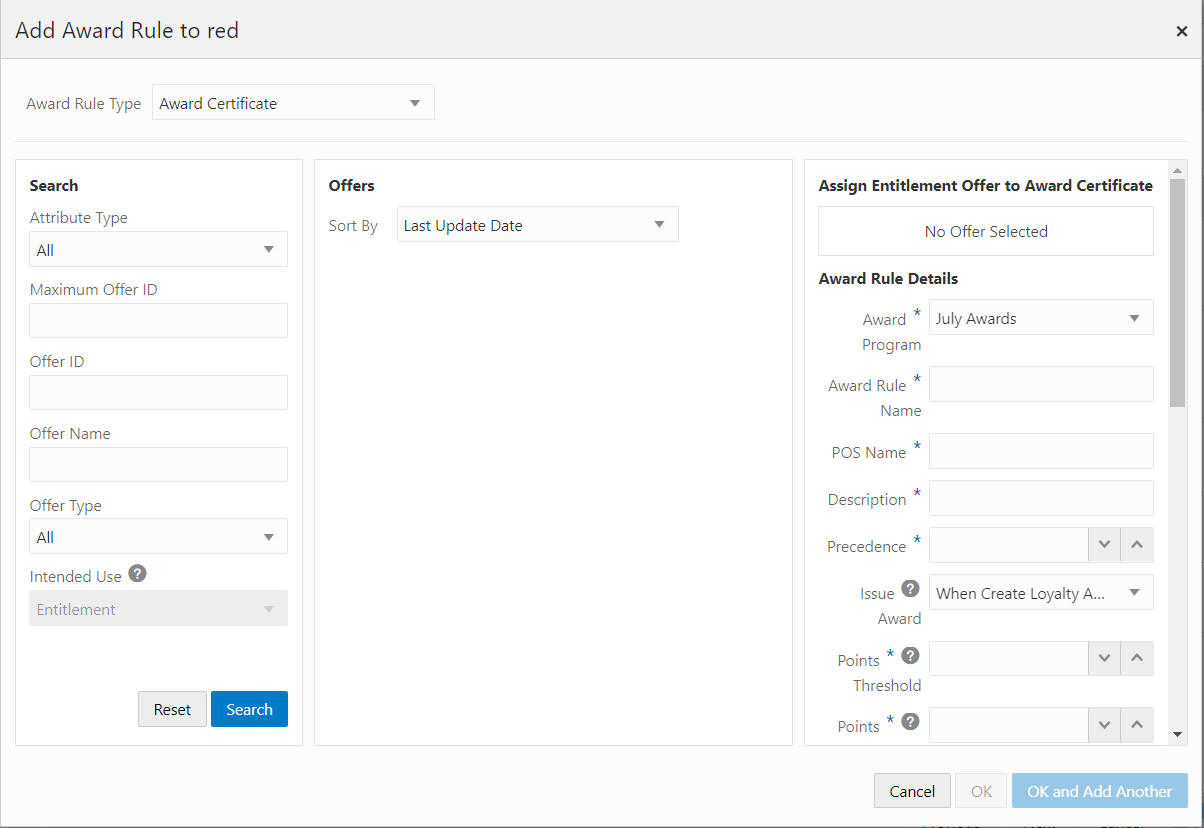
There are five sections; Search, Offers, Assign Entitlement Offer to Award Certificate, Award Rule Details, and Certificate Details.
-
-
Search - Use this section to populate the Offers Section. Fields include:
-
Attribute Type
-
Maximum Offer ID
-
Offer ID
-
Offer Name
-
Offer Type
-
Intended Use
Note:
The Intended Use field is disabled and uses the default value of Entitlement. Only offers with an Intended Use of Entitlement are assigned to an award certificate.
-
-
Click Search to populate the Offers Section. Click Reset to clear all Search fields.
-
Sort By - Select an option to sort by the following:
-
Last Update Date
-
Offer ID
-
Offer Name
-
Offer Type
-
-
Click Add to populate the Assign Entitlement Offer to Award Certificate section.
Assign Entitlement Offer to Award Certificate
-
Click the X to remove an offer. Return to the Offers section to select a new offer to assign.
Award Rule Details
-
Select the Award Program.
Note:
An Award Certificate can be previously created in an Award Program on the same card as the Loyalty Program. Additionally, a new Award Certificate can be created from the Loyalty Program and associated with an Award Program on the same card. If an existing award certificate exists for the selected offer, the Award Program will be defaulted into the options list. If the offer is NOT associated with an existing award certificate, the first active award program on the card will display by default and the award certificate will be created from the Loyalty Program.
-
Enter an Award Rule Name.
-
Enter a POS Name.
-
Enter a Description.
-
Enter the Precedence (Order in which the Award Rule will be applied if more than one Award Rule is effective).
-
Select Issue Reward setting.
Note:
When the Issue Certificate is set to Immediately Upon Transaction Posting, the award certificate will be issued to a customer account as soon as the system processes the purchase activity. If the selection is set to When Create Loyalty Award Job Runs, the award certificate is issued after the scheduled job runs.
-
Enter the Points Threshold.
-
Enter the Points Cost.
-
Enter the Start Date.
-
End Date - Toggle the End Date to On to enter an End Date if desired.
-
Enter the Coupon Prefix.
-
Award Certificate Expires - Toggle to On to configure the expiry settings.
-
Select an Expiration Type.
Relative - Enter the Expires After value and select a Time Period.
Program - Award Certificate will use the Award Expiration defined for the award program the Award Certificate will be held in.
Certificate Details
Note:
If the user selects an offer that is already assigned to an existing award certificate, the fields in the Certificate Details section will be populated and will be read only.
-
-
Enter the Award Certificate Name.
-
Enter the Description.
-
Enter the Precedence (Order in which the Award Rule will be applied if more than one Award Rule is effective).
-
Toggle Unlimited Redemption to On to allow unlimited redemptions.
-
Enter the number of Maximum Redemptions (Displays when Unlimited Redemptions is OFF).
-
-
Either click OK to accept all changes for the configured Award Rules or click Cancel to close without saving.
Note:
Before you save the Program, you can use the tab links along with Previous and Next to go back to any point in the create program process and make changes.
-
When finished entering all Award Rules, click Next to go to the Movement Rules tab.
Movement Rules determine how customers are moved from one Loyalty Level to another. Movement Rules are accessed through the Loyalty Level to which they belong.
Figure 10-42 Movement Rules Tab
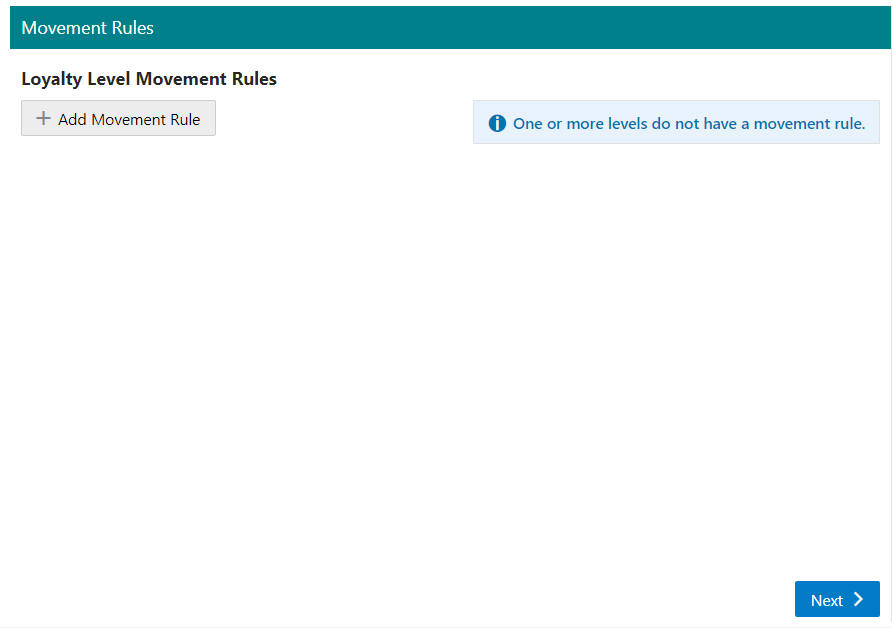
-
Click + Add Movement Rule.
-
Select a Movement Rule Type.
-
Advancement - The Customer Account is moving to a higher level.
-
Sustain - The move is a lateral move.
-
Demotion - The Customer Account is moving to a lower level.
-
-
Select the Levels to configure using the From, To, or Sustain option list.
Note:
Advancement and Demotion Movement Rule Types both use the From and To option lists. The Sustain Movement Rule Type uses the Sustain option list. All three Movement Rule Types share the same Movement Rule and Test Details.
Movement Rule Details
Figure 10-43 Movement Rule Details
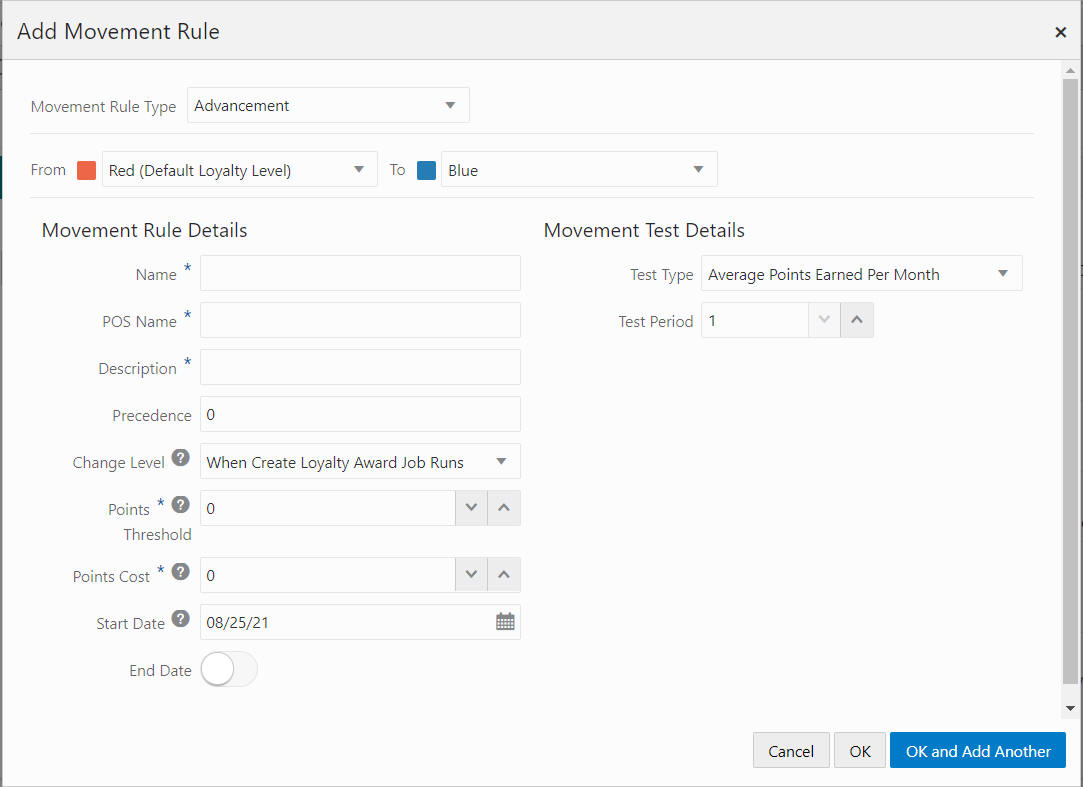
-
Enter the Name.
-
Enter the POS Name.
-
Enter the Description.
-
Enter the Precedence (Order in which the Award Rule will be applied if more than one Movement Rule is effective).
-
Select Change Level setting.
Note:
When the Change Level is set to Immediately Upon Transaction Posting, the movement rule will be applied to a customer account as soon as the system processes the purchase activity. If the selection is set to When Create Loyalty Award Job Runs, the movement rule will be applied when the scheduled job runs.
-
Enter the Points Threshold.
-
Enter the Points Cost.
-
Enter the Start Date.
-
End Date - Toggle the End Date to On to enter an End Date if desired.
Movement Test Details
-
Select the Test Type. Type of test performed to determine whether a Customer should be moved. This Selection Menu has the following options:
-
YTD Points - Movement depends upon the number of points earned year-to-date in the Customer account.
-
LTD Points - Movement depends upon the number of points earned lifetime-to-date in the Customer account.
-
Points Earned Since Last Level Move - Movement depends upon the number of points earned since the last level move, or the creation of the Customer account.
-
Average Points Earned Per Month - Movement depends upon the average number of points earned per month in a defined number of months.
-
Time Period Since Last Level Move - Movement occurs after a defined period of time has passed since the last level move, or the creation of the Customer account.
-
-
Enter the Test Period. The number of periods (from Test Period Type) used for the movement test (visible only if the Test Type is either Average Points Earned Per Month or Time Period Since Last Level Move).
-
Enter the Test Period Type. The type of period used for the movement test (visible only if the Test Type is Time Period Since Last Level Move)
-
Extend Sustain Period - When the toggle is on, then customers remain at the same level for an additional amount of time past the test period until the customer meets additional criteria.
-
Select the Extension Test Type.
-
Enter the Extension Test Period (only visible when the Extension Test Type is Average Points Earned Per Month).
-
Enter the Extension Points Threshold.
-
Enter an Extend By value.
-
Enter the Period Type.
-
-
Click OK to save, click Cancel to close without saving, or click OK and Add Another to save the Movement Rule and configure additional Movement Rules.
-
-
When finished defining Movement Rules do the following:
-
The Card Definition tab allows you to add a card image and identify the contact details if there is a supplier for the physical cards. Enter the following information:
Figure 10-44 Card Definition Tab

Card Details
-
Card Type - Type of Card.
-
Description - Description of Card.
-
Serial Number Prefix - The Card Serial Number Prefix for this Card Definition.
-
Active - Indicates whether the Card Definition is currently active.
-
Generate Pin - Toggle on to enable Customer Engagement to generate PINs for the Cards.
-
PIN Length - The length of each PIN. (This field is only visible if the Generate Pin Toggle is On). Enter 0 [default] for Cards that will not have PINs.
-
-
PIN Required - For each Check Box, indicate whether a PIN is required for that situation. (These fields are only visible if the Generate Pin Toggle is On.)
-
Always - A customer must enter a PIN every time their Card is used.
-
Without Card - A customer must enter a PIN if they do not have their Card.
Card Image (Optional)
You can also edit the image once it has been added.
-
-
Click Add Image. The Add Card Image window opens.
Figure 10-45 Add Card Image
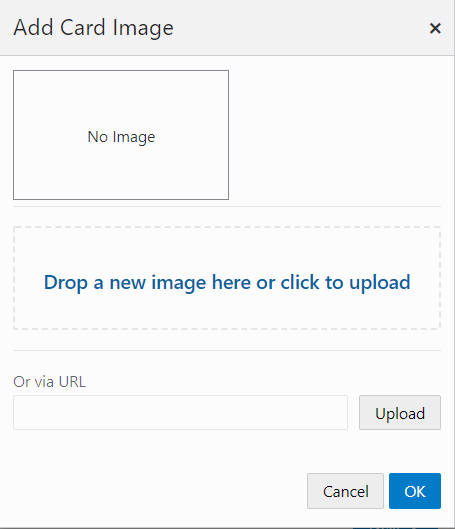
To add a new Card Image, either:
-
Drag and Drop a new image as shown in Figure 10-45.
-
Click anywhere in the Drop a new image here or click to upload box.
-
Or Via URL - Enter the URL of the image, then click Upload to complete the process.
-
-
Either click OK to create the add the card image or click Cancel to close without saving.
Card Supplier
-
From Supplier - Toggle On to enter the following Supplier details:
-
Supplier Name
-
Address Line 1
-
Address Line 2
-
Address Line 3
-
City
-
State
-
Postal Code
-
Country
-
Phone Number
-
-
-
When finished entering the Program information on the Card Definition tab, click Next to continue to the Card Series tab.
-
The Card Series tab enables you to setup a new card series at the same time you are defining a new card. Enter the following information:
Figure 10-46 Add Card Series
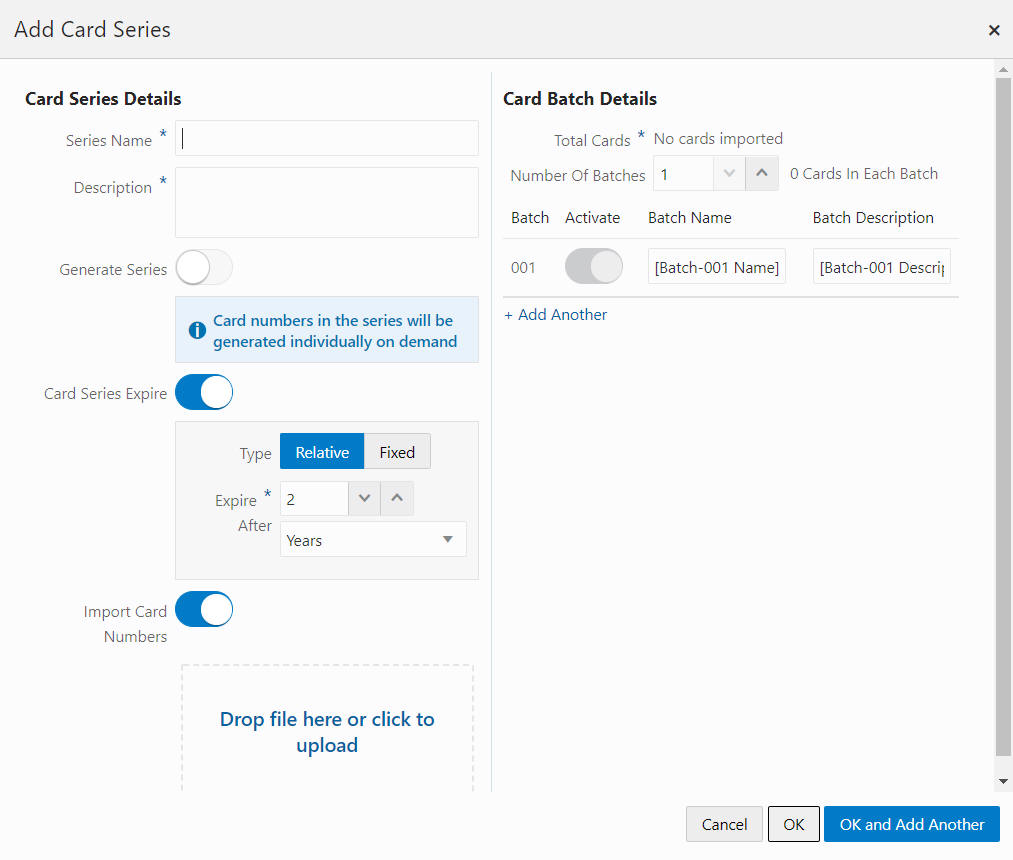
Card Series Details
-
Series Name - Name of the Card Series Distribution.
-
Description - Description of the Card Series Distribution.
-
Generate Series
-
Toggle on - When the wizard is completed, the card series is generated.
-
Toggle off (Default) - Card numbers in the series are generated individually on demand.
-
-
Card Series Expire - Determines the type of expiration date to use for the Card Series Distribution. This Selection Menu has the following options:
-
Relative - The ending expiration date will be a certain, defined period of time after the initial activation date. If this option is selected, the Expire After section displays the Number of Periods and Period Type fields.
-
Fixed - Beginning and ending expiration dates are defined by the User.
-
-
To Import Card Numbers, either:
-
Drag and Drop a file as shown in Figure 10-47.
Figure 10-47 Import Card Numbers
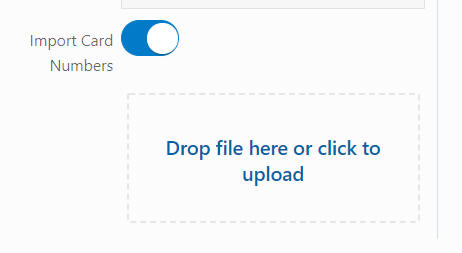
-
Click anywhere in the Drop file here or click to upload box.
Figure 10-48 Import Card Numbers
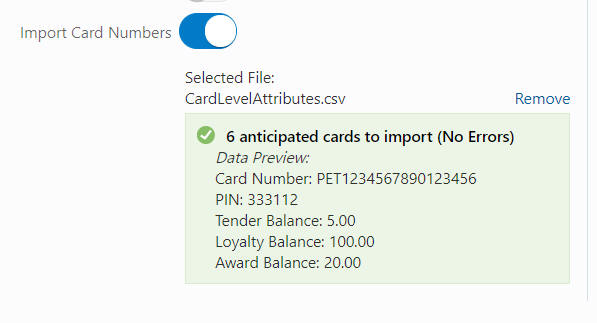
Card Import File Field Information
When importing external card numbers for a card series, the Import File listing the numbers must have the following fields for each line:
-
-
CARD_NUMBER [required]
-
CARD_PIN_NUMBER [optional]
-
Tender Balance Amount [optional]
-
Loyalty Balance Amount [optional]
-
Award Balance Amount [optional]
-
ATTRIBUTE NAME 1 [optional]
-
ATTRIBUTE VALUE 1 [optional], but required if ATTRIBUTE NAME 1 specified
-
ATTRIBUTE NAME 2 [optional]
-
ATTRIBUTE VALUE 2 [optional], but required if ATTRIBUTE NAME 2 specified
-
ATTRIBUTE NAME 3 [optional]
-
ATTRIBUTE VALUE 3 [optional], but required if ATTRIBUTE NAME 3 specified
-
ATTRIBUTE NAME 4 [optional]
-
ATTRIBUTE VALUE 4 [optional], but required if ATTRIBUTE NAME 4 specified
-
ATTRIBUTE NAME 5 [optional]
-
ATTRIBUTE VALUE 5 [optional], but required if ATTRIBUTE NAME 5 specified
A placeholder must be used for all fields. For example, to include a card number of 1234567890123456 with a PIN of 123456, a Tender Balance Amount of 10, a Loyalty Balance Amount of 20, an Award Balance Amount of 30, and a CARD_REDEMPTION_ INFO attribute of Redeemed Solon, OH, the following line would be included in the Import File:
1234567890123456,123456,10,20,30,CARD_REDEMPTION_INFO,"Redeemed Solon, OH",,,,,,,
Note the empty fields for the remaining four attribute names and values in the example.
Card Import File Validation
-
The card numbers cannot be duplicates to any cards already in the database.
-
The card number prefixes must be valid for the card definition.
-
The activation amounts must be valid numbers.
-
The card number length does not need to match the length specified for the card definition.
-
If an activation amount is provided in the import file, the card will be activated upon creation. If no amounts are provided the card will remain inactive.
-
The activation amounts are in the program’s base currency.
Remove an Imported File
You have the option to remove the file at any time before the wizard is completed. Click Remove to remove the imported file.
Note:
The Import Card Numbers option is not allowed once cards have been generated for the card series.
Card Batch Details
-
Total Cards - Total Number of cards to be generated for the Card Definition.
Note:
This field is filled in automatically when card numbers are imported.
-
Number of Batches - The number of separate Card batches included in the Card Series Distribution.
Activate Cards
When the wizard is completed, the cards in the batch set to activate will be set to active. If this is toggled off, the cards can be activated from the Card Series tab or from the View Card screen.
To activate a set of Cards within Card Series configuration:
Figure 10-49 Card Batch Details
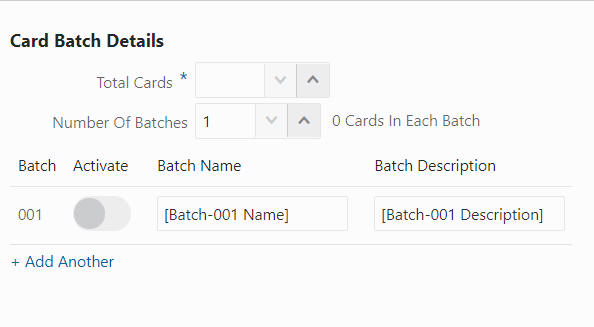
-
Activate - Toggle on to activate the Cards when the wizard is completed.
-
Enter a Batch Name.
-
Enter a Batch Description.
Note:
Click + Add Another to add another batch. You can also adjust the Number of Batches field. Click the X icon next to each Batch to remove a batch from the list.
-
Click OK to add the Card Series to the Program or click OK and Add Another to add another Card Series. Click Cancel to close the window without adding the Card Series.
Edit Card Series
Figure 10-50 Card Series Details
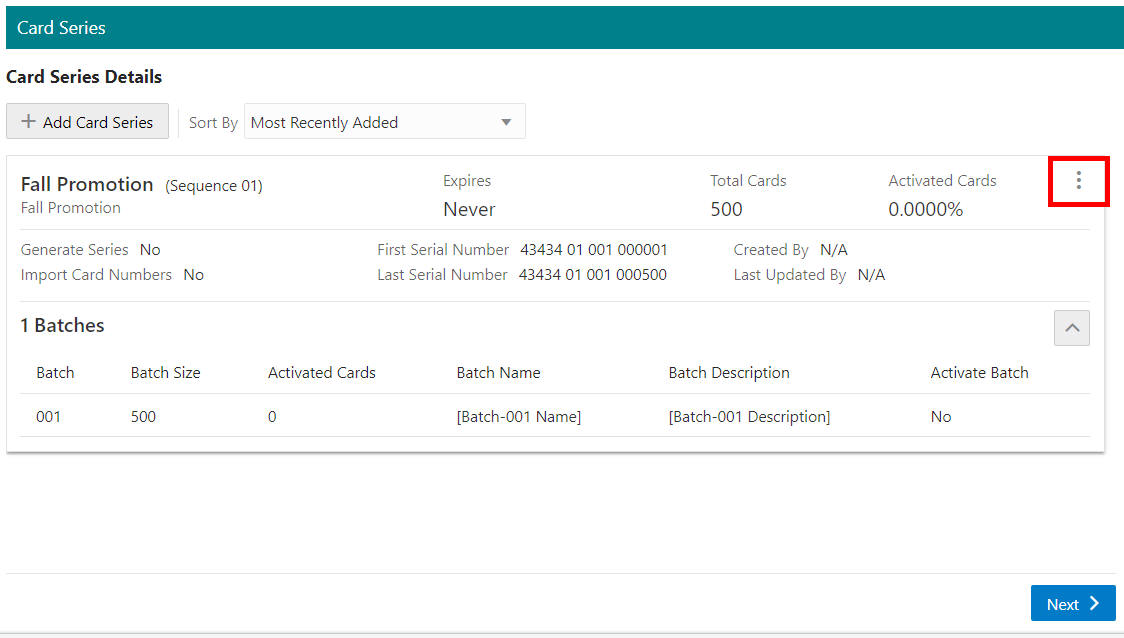
To Edit an existing Card Series click the Action menu and select, Edit. The Edit Card Series window opens. See Step 31, the Card Series tab to edit the card.
Remove a Card Series
To Remove an existing Card Series, click the Action menu and select, Remove. The Card Series is deleted immediately.
Note:
Before you save the Program, you can use the tab links along with Previous, Next, or Cancel to go back to any point in the create program process and make changes.
-
-
When finished entering the Program information on the Card Series tab, click Next to continue to the Attributes tab.
Enter the following for the Attributes tab. Attributes can be added to the Card Type to further distinguish qualifications for the Offer.
Figure 10-51 Attributes - Card Type Attributes
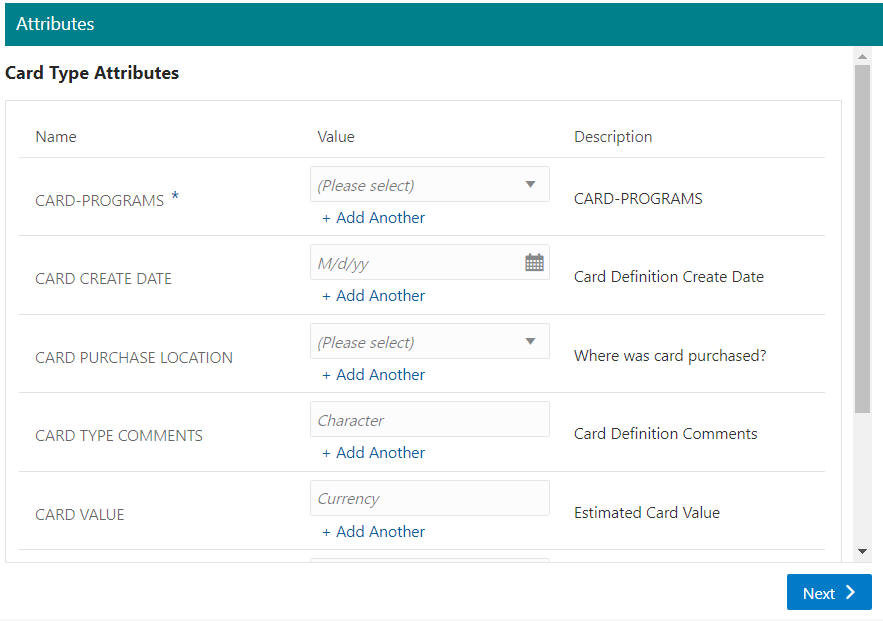
Figure 10-52 Attributes - Card Series Attributes
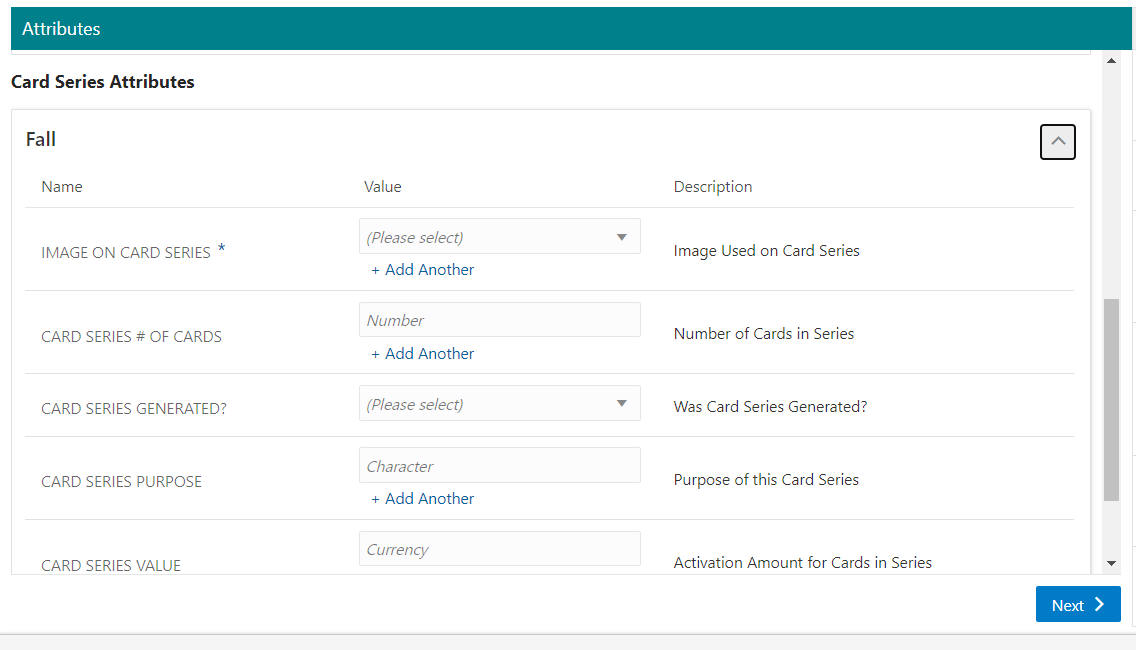
-
Select or enter the Values for each of the required attributes (indicated by an asterisk*).
-
Add Values for any optional attributes.
-
Select or enter the configuration value for the Attribute.
Note:
Repeat this step for all optional Attributes you wish to add to the Card or Card Series.
-
-
When finished defining any attributes for the Program, click Next to continue to the Review tab (Assigned to New Card).
-
The Review tab (Assigned to New Card) displays key elements in the Program Setup. Review the following for the Tender Program Type.
Figure 10-53 Tender Program - Review Tab (Assigned to New Card)
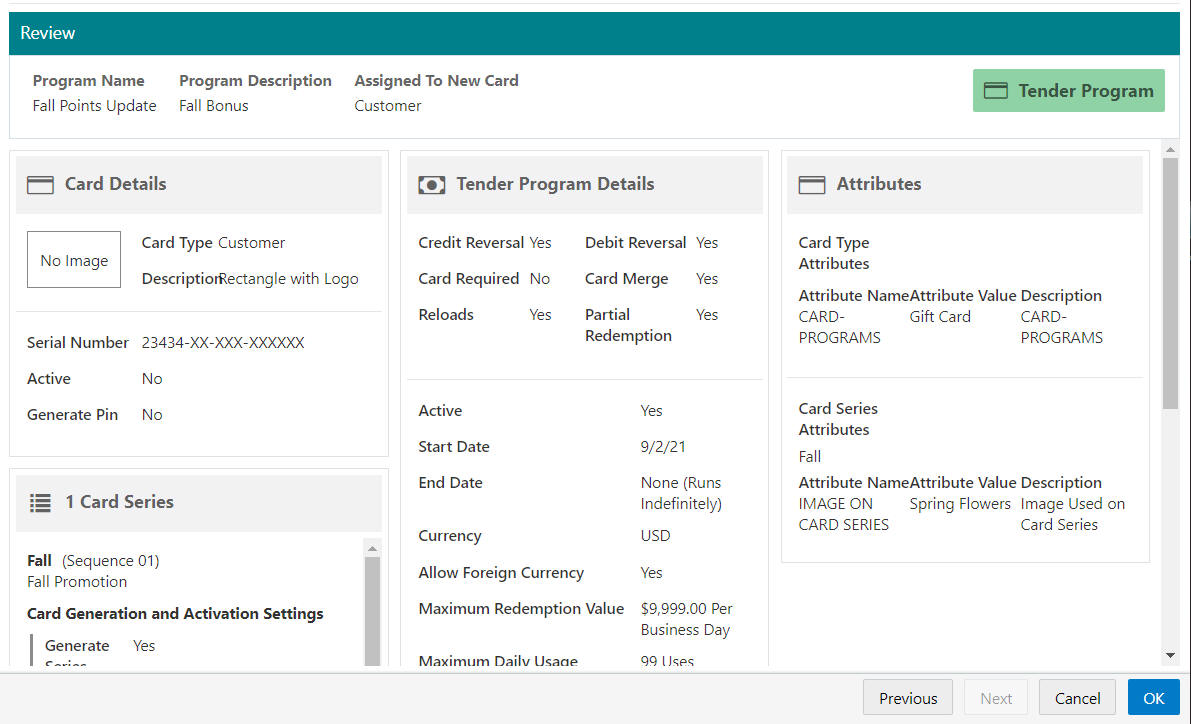
-
Either click OK to create the Program or click Cancel to close without saving.
Note:
Before you save the Program, you can use the tab links along with Previous and Next to go back to any point in the create program process and make changes.
-
The Review tab (Existing Card) displays key elements in the Program Setup. Review the following for the Tender Program Type.
Figure 10-54 Tender Program - Review Tab (Assigned to Existing Card)
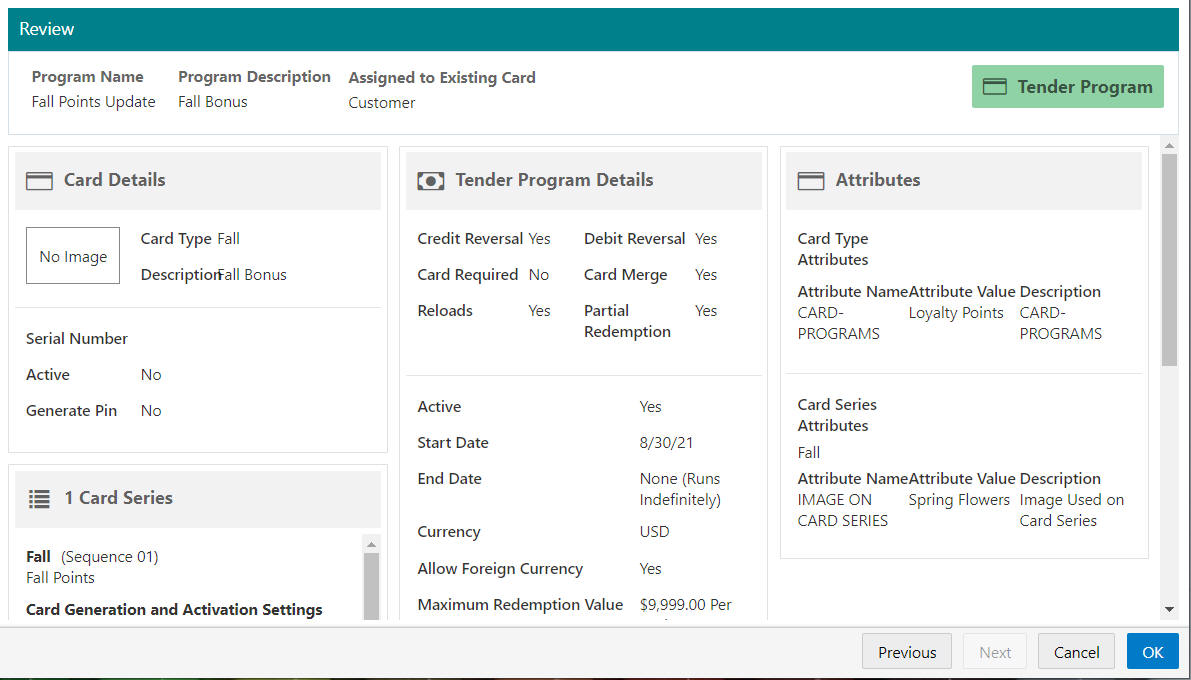
-
Either click OK to create the Program or click Cancel to close without saving.
Note:
Before you save the Program, you can use the tab links along with Previous and Next to go back to any point in the create program process and make changes.
-
The Review tab (Assigned to New Card) displays key elements in the Program Setup. Review the following for the Loyalty Program Type.
Figure 10-55 Loyalty Program - Review Tab (Assigned to New Card)
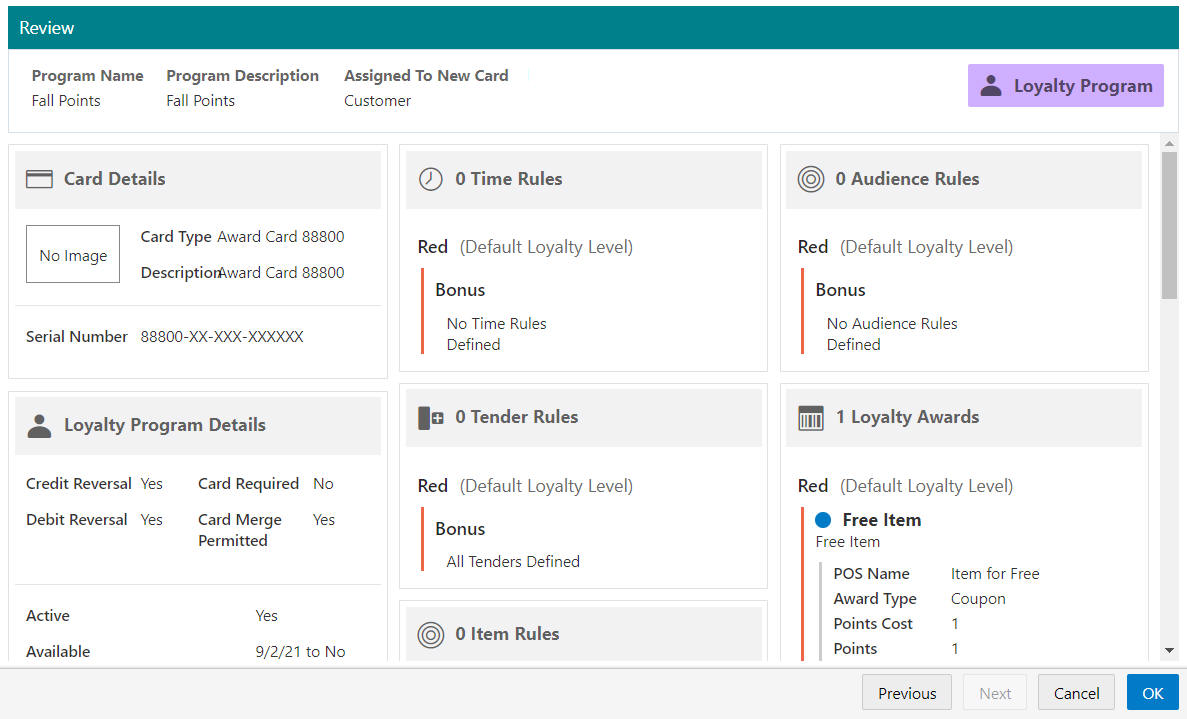
-
Either click OK to create the Program or click Cancel to close without saving.
Note:
Before you save the Program, you can use the tab links along with Previous and Next to go back to any point in the create program process and make changes.
-
The Review tab (Existing Card) displays key elements in the Program Setup. Review the following for the Loyalty Program Type.
Figure 10-56 Loyalty Program - Review Tab (Assigned to Existing Card)
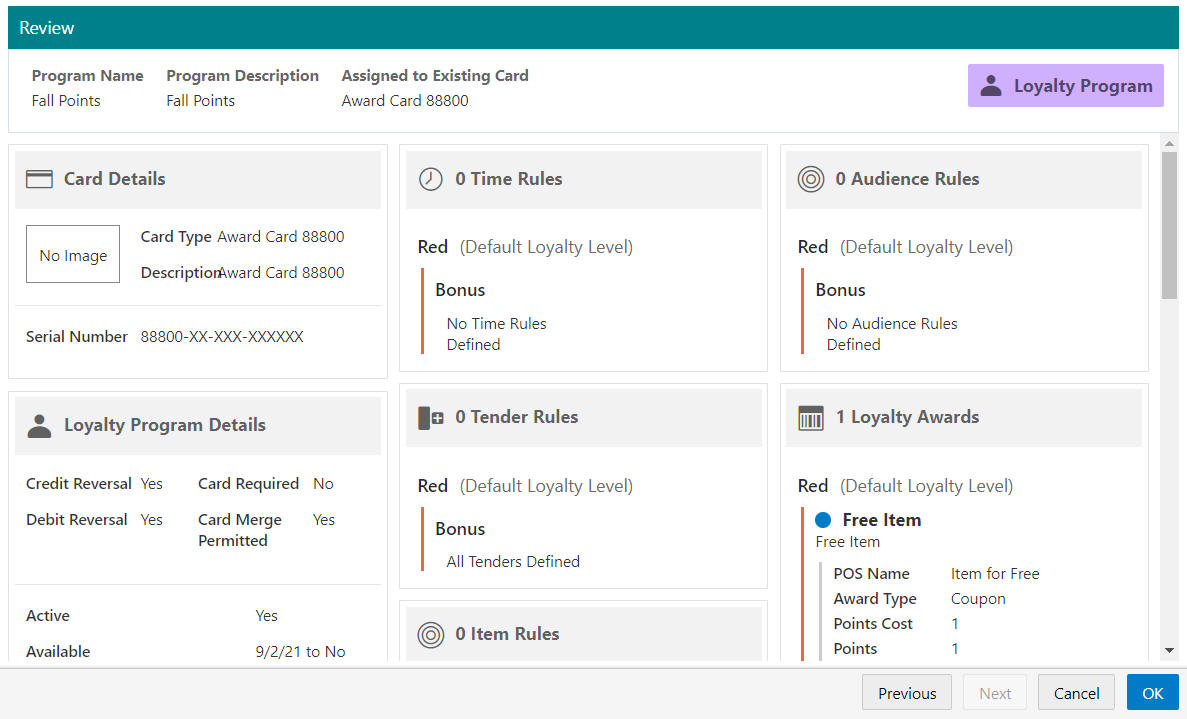
-
Either click OK to create the Program or click Cancel to close without saving.
Note:
Before you save the Program, you can use the tab links along with Previous and Next to go back to any point in the create program process and make changes.
-
The Review tab (Assigned to New Card) displays key elements in the Program Setup. Review the following for the Award Program Type.
Figure 10-57 Award Program - Review Tab (Assigned to New Card)
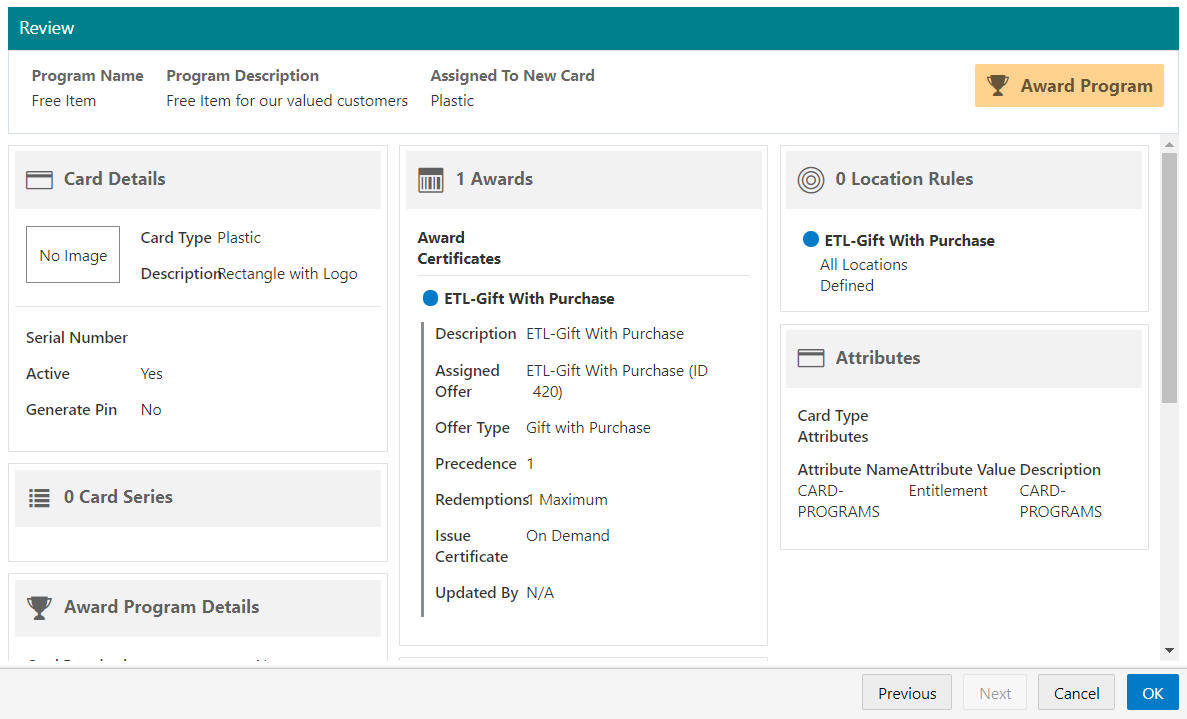
-
Either click OK to create the Program or click Cancel to close without saving.
Note:
Before you save the Program, you can use the tab links along with Previous and Next to go back to any point in the create program process and make changes.
-
The Review tab (Existing Card) displays key elements in the Program Setup. Review the following for the Award Program Type.
Figure 10-58 Award Program - Review Tab (Assigned to Existing Card)
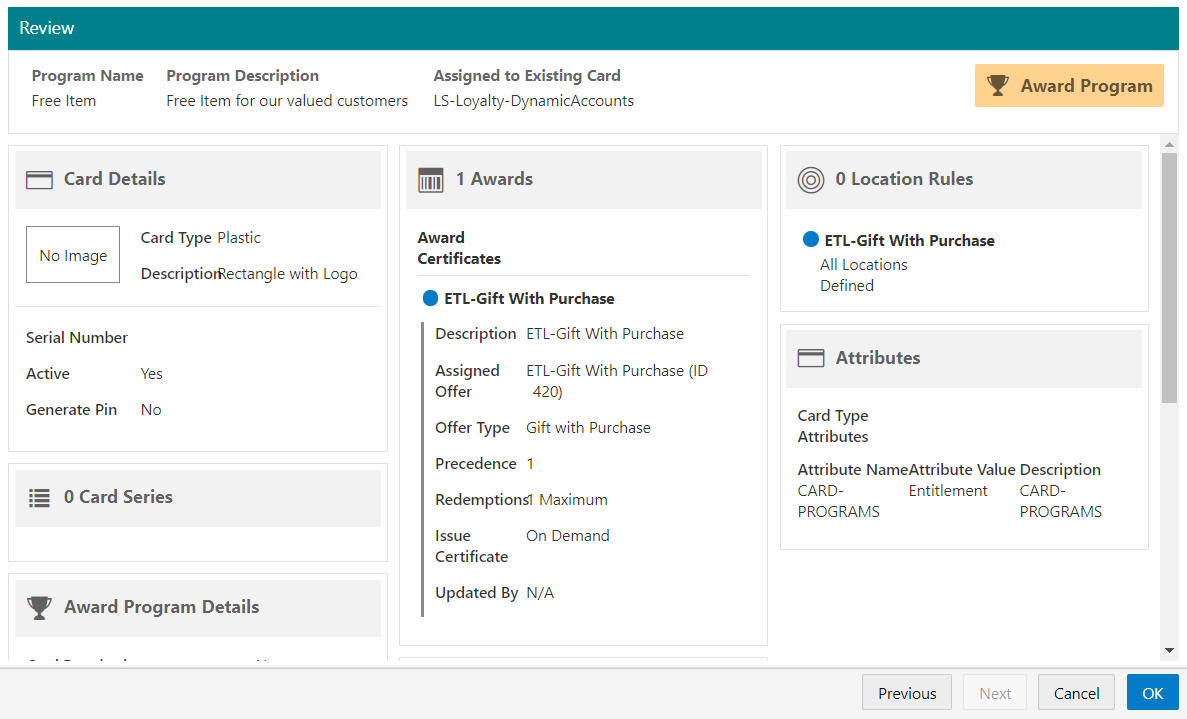
-
Either click OK to create the Program or click Cancel to close without saving.
Note:
Before you save the Program, you can use the tab links along with Previous and Next to go back to any point in the create program process and make changes.
Editing Programs
You can access Programs for editing using the following methods to display the Edit Program option:
-
Program Advanced Search Results
-
Click the Action Menu icon on the far right in the data display section for an individual Program in the Program Advanced Search window (Program Result Section).
-
Click Edit Program.
Figure 10-59 Action Menu Options (Program Advanced Search)

-
-
Program Home Quick Search
-
Click the Action Menu icon on the far right in the data display section for each individual Program in the Programs Quick Search window located in Program Home.
-
Click Edit Program.
Figure 10-60 Action Menu Options (Program Quick Search)
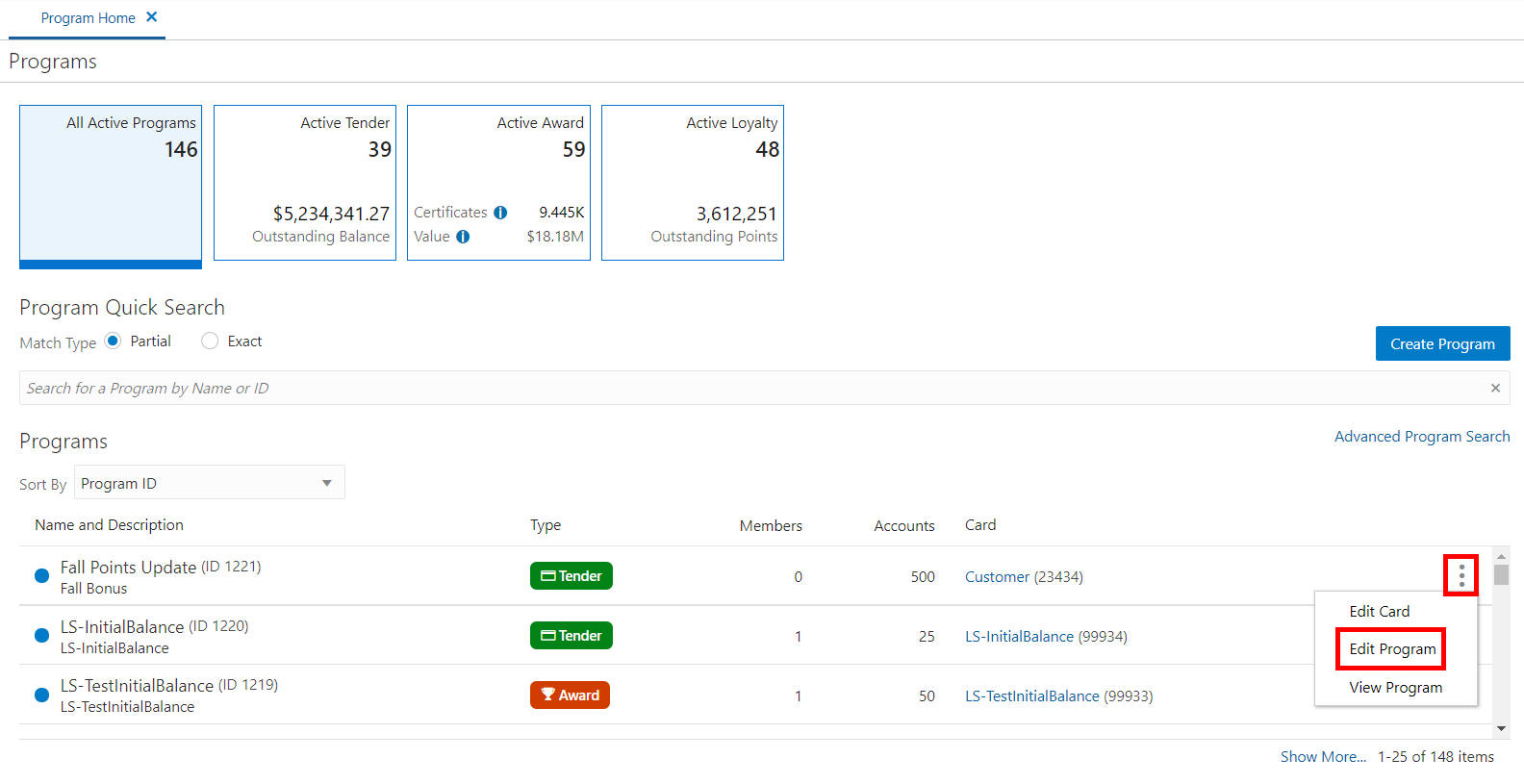
-
Click Done to close the Program and return to the Search Results.
Note:
For detailed information on each section while editing a Program, see Creating a Program.
Viewing Programs
You can access a Program for viewing using the following methods to display the View Program option:
-
Program Advanced Search Results
-
Click the Action Menu icon on the far right in the data display section for each individual Program in the Program Advanced Search window (Program Search Results Section).
-
Click View Program. The View Program screen displays. See Figure 10-64.
Figure 10-61 Action Menu Options (Program Advanced Search) - View Program
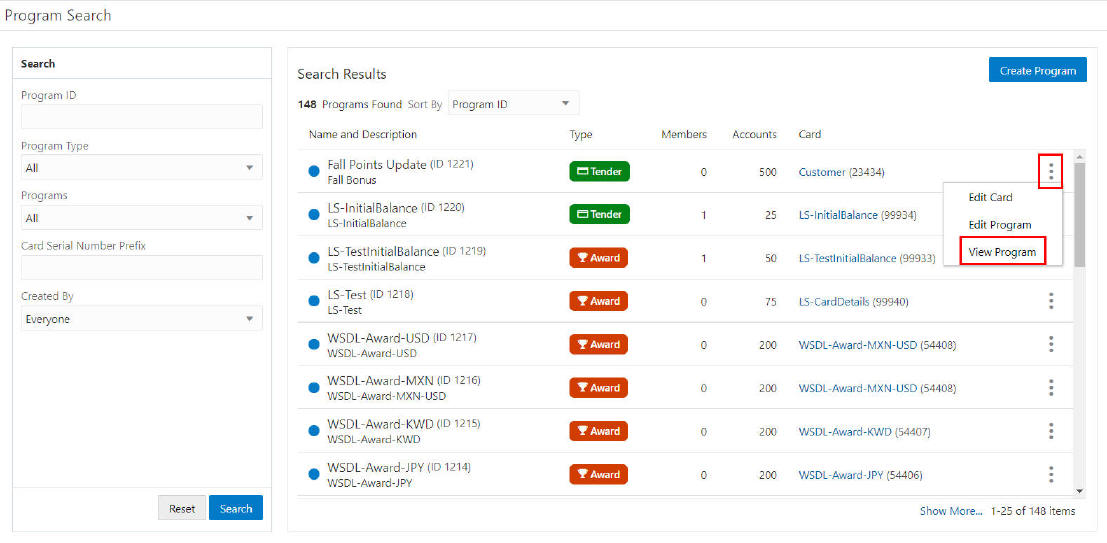
-
-
Program Quick Search
-
Click the Action Menu icon on the far right in the data display section for each individual Program in the Program Quick Search window.
-
Click View Program. The View Program screen displays. See Figure 10-64.
Figure 10-62 Action Menu Options (Program Quick Search) - View Program
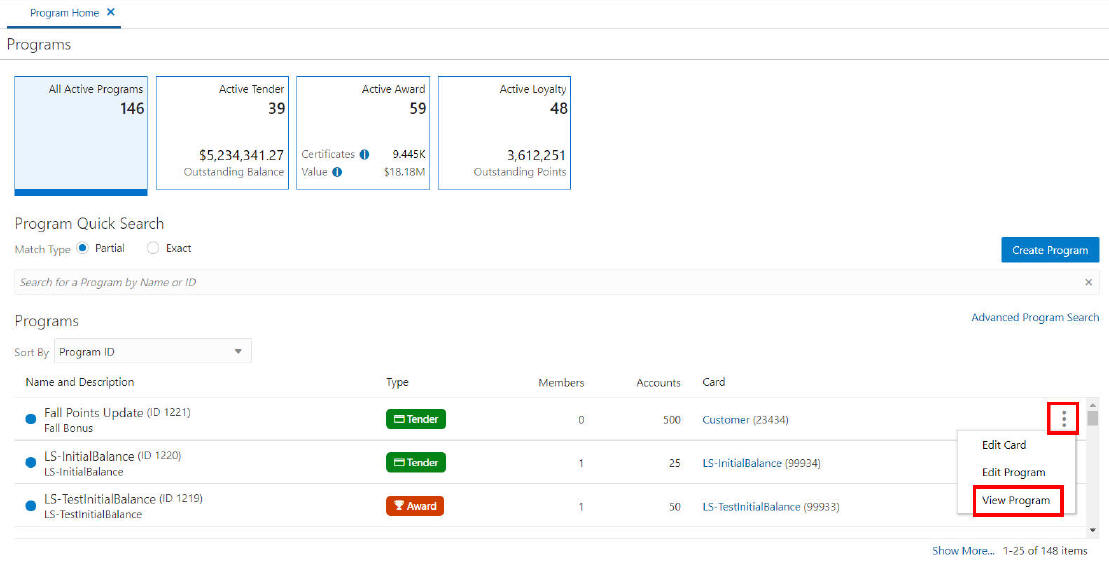
-
-
Program Scorecard - Click the Program Name link in the Program Information panel. The View Program screen displays. See Figure 10-64.
Figure 10-63 View Program - Program Scorecard
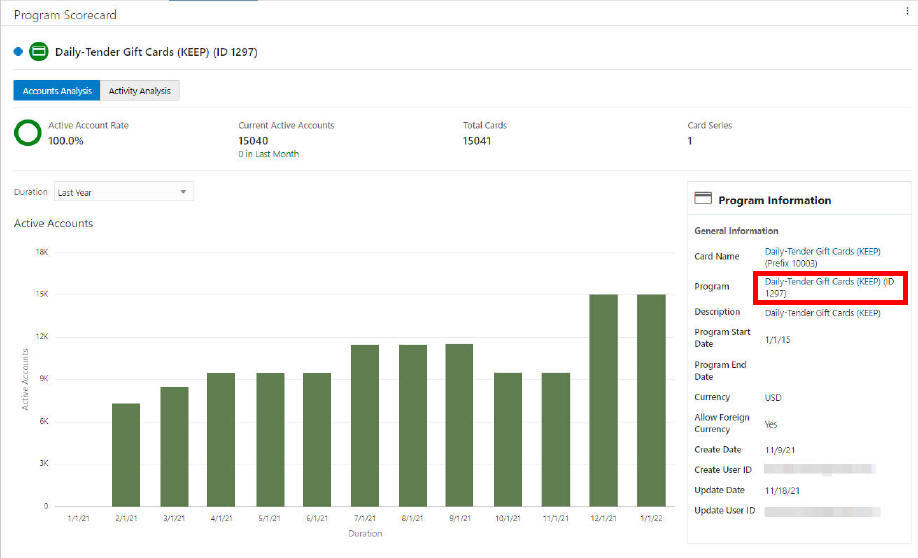
Note:
The Program Screen is a compilation of what is created during the Create Program wizard process and appears as the Review tab. See Creating a Program for more details about what each panel represents in the Program screen.
View Program - Action Menu Options
Figure 10-64 Program Screen
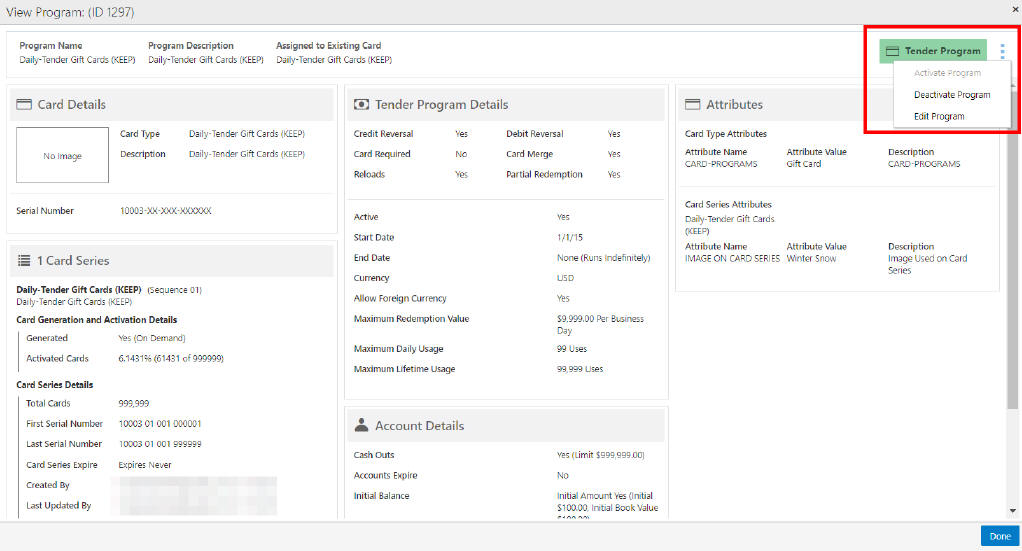
The Action Menu options include:
-
Activate Program - Available when Program Status is Deactivated
-
Deactivate Program - Available when Program Status is Activated
-
Edit Program - See Editing Programs for details.
Click Done to close the Program and return to Program Home. For detailed information on each section see Creating a Program.
Cards
Cards include information about cards held by the customer and about the programs associated with each card. Programs include Tender, Award, and Loyalty.
Note:
This section deals with Cards associated with a Program. See Card Administration for information on administering Card and Account details.
Viewing Cards
The following options enable you to view Cards already associated with a Program.
-
Program Home - From the Card column in the Programs Quick Search results area click the Card's name link as shown in Figure 10-62.
-
Program Search - From the Card column in the Search Results area click the Card's name link as shown in Figure 10-61.
-
Program Scorecard - From the Program Information panel, click the Card’s name link as show in Figure 10-63.
The View Card window opens. You can select to view the Card Series or Programs.
Figure 10-65 View Card - Card Series
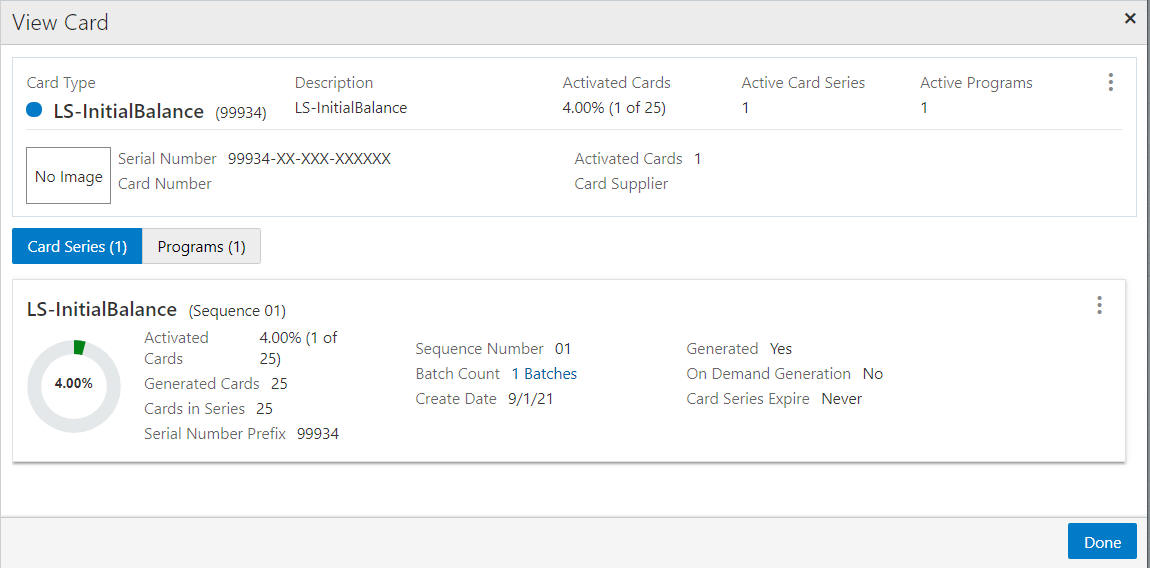
View Card - Card Series Actions
The following actions for Card Series are available from the View Card window.
Edit Card
See Editing Cards for details.
Note:
The Activate Batch, Change Batch Expiration Date, Deactivate Card Series Batch will also be made available on the Card Series Tab when the user selects Edit Card.
Activate Batch
-
Click the Action Menu and select Activate Batch. The Activate Card Series Batch window opens.
Figure 10-66 Activate Card Series Batch
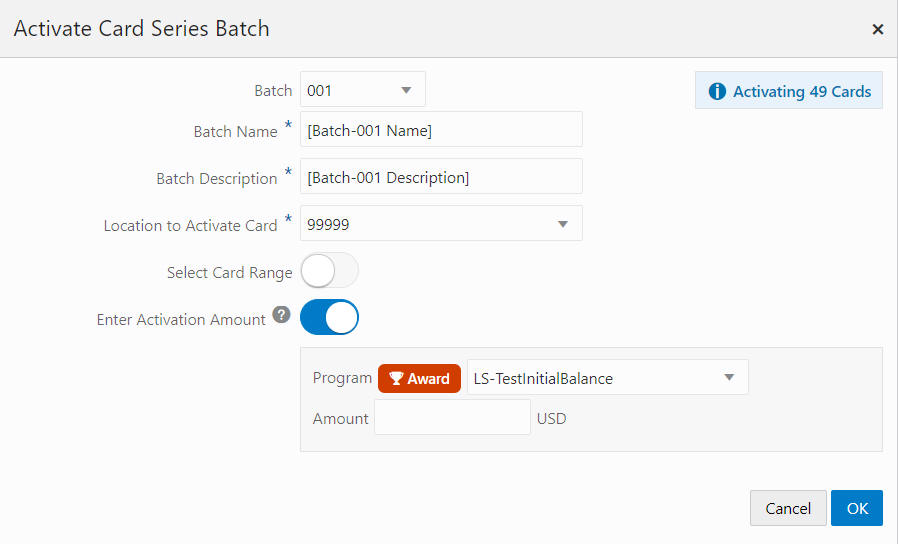
-
Enter the following information:
-
Batch - Batch Number
-
Batch Name - Name of the Batch
-
Batch Description - Description of the Batch
-
Location to Activate Card - The location where the cards are active.
-
Select Card Range - Toggle to On to enter a specific Card Range.
-
Enter Activation Amount - When this option is toggled to On, the initial amount set up for the program can be overridden when activating the card. If an amount is not selected, the amount defined for the program will be used.
-
-
Either click OK to accept the changes and activate the Card Series Batch or click Cancel to close the window without saving.
Change Batch Expiration Date
-
Click the Action Menu and select Activate Batch. The Activate Card Series Batch window opens.
Figure 10-67 Change Batch Expiration Date
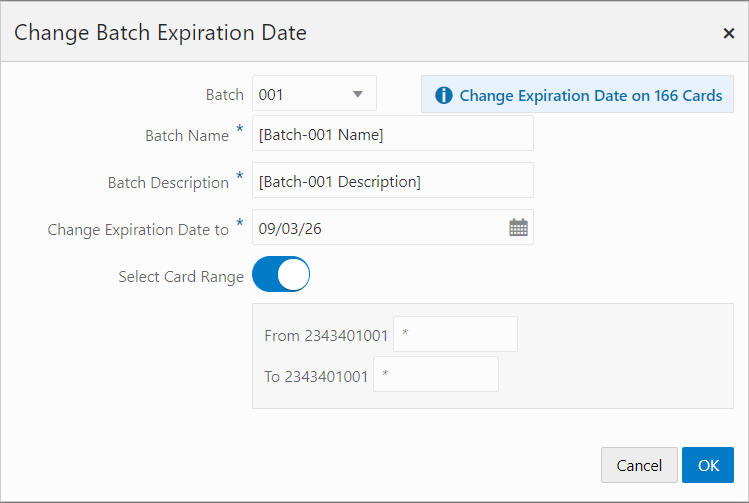
-
Enter the following information:
-
Batch - Batch Number
-
Batch Name - Name of the Batch
-
Batch Description - Description of the Batch
-
Change Expiration Date to - The new expiration date.
-
Select Card Range - Toggle to On to enter a specific Card Range.
-
-
Either click OK to accept the changes or click Cancel to close the window without saving.
Note:
The information box displays the number of cards impacted by the approval of the action.
Deactivate Card Series Batch
-
Click the Action Menu and select Deactivate Batch. The Deactivate Card Series Batch window opens.
Figure 10-68 Deactivate Card Series Batch

-
Enter the following information:
-
Batch - Batch Number
-
Batch Name - Name of the Batch
-
Batch Description - Description of the Batch
-
Select Card Range - Toggle to On to enter a specific Card Range.
-
-
Either click OK to accept the changes and Deactivate the Card Series Batch or click Cancel to close the window without saving.
Note:
The information box displays the number of cards impacted by the approval of the action.
Generate Card Series
Click the Action Menu and select, Generate Card Series. A notification indicates the successful job submission.
Figure 10-69 Job Submission Notification

View Card - Programs Actions
The following actions for Card Series are available from the View Card window.
Note:
If more than one Program is associated with a Card, a selection list enables you to select a Program.
-
Activate Program - Click the Action Menu icon, then select Activate Program.
-
Deactivate Program - Click the Action Menu icon, then select Deactivate Program.
Note:
For Activate and Deactivate Programs a notification appears.
Figure 10-70 Activate/Deactivate Notification

-
Edit Program - See Creating a Program for details.
Editing Cards
Once a program has been created, you can edit the card associated with the program. You have the ability to edit certain information in the Franchisees, Card Definition, Card Series and Attributes tab. Once changes are made you can save the edited card.
There are a few places you can find the Edit Card option in order to edit a Card associated with a Program:
-
Select Edit Card in the Action Menu (also known as the Overflow Menu) icon for each individual Program on the Program Advanced Search window.
-
Select Edit Card in the Action Menu (also known as the Overflow Menu) icon for each individual Program on the Program Quick Search window.
Figure 10-71 Action Menu - Edit Card

-
Select Edit Card in the Action Menu (also known as the Overflow Menu) icon in the View Card window.
During the editing process the Franchisees, Card Definition, Card Series and Attributes tabs available for editing. See Creating a Program for more information.
Program Scorecards
The Program Scorecard provides statistical analysis about an individual Tender, Award, or Loyalty Program. The scorecard displays the number of accounts and activity for the program in order to see how much the program is being used, including outstanding balances.
Viewing the Tender Program Scorecard
The Program Scorecard provides a snapshot of how a Tender Program is doing.
To access the Program Scorecard for analysis on a Tender Program, the user can select the Tender Program name link on either the Programs List or the Programs Advanced Search results windows.
To access the Programs List:
-
From the Main menu, click Tasks.
-
Click Program.
-
Click Program Home. This displays the Program Home tab which contains the Program List.
Note:
You will need the Program Home role in order to see this menu option.
Figure 10-72 Program Home

To access Program Advanced Search:
-
From the Main menu, click Tasks.
-
Click Program Search.
-
Enter criteria in the Search panel where you can search for a unique program, or click Search to retrieve all programs.
Figure 10-73 Advanced Program Search

-
Select the link on a Tender Program Name, which then opens the Program Scorecard for that Tender Program.
Figure 10-74 Program Scorecard: Tender Program
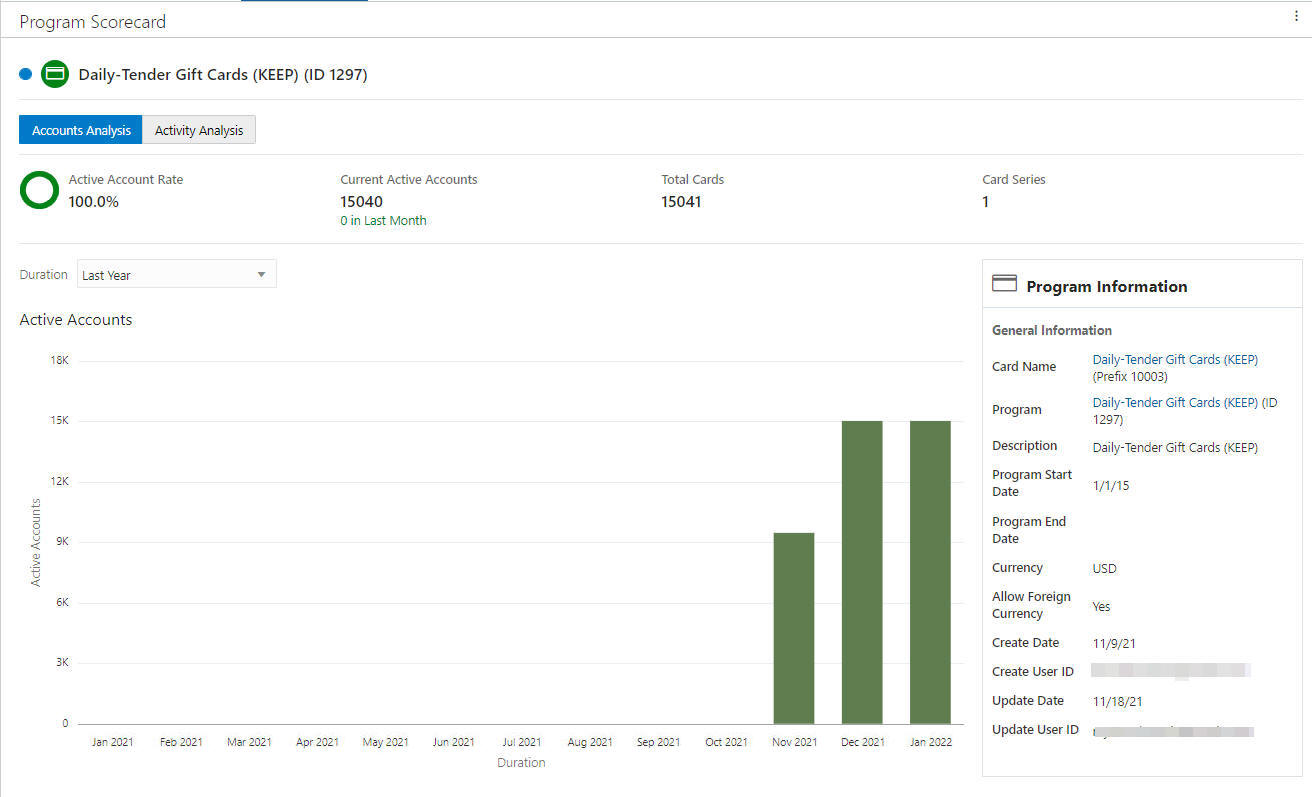
-
The Program Scorecard window displays the following sections:
-
Title (displays on all windows) - Displays the Name and ID of the Tender Program as well as an indicator of whether the program is currently active or inactive (a solid Blue Dot represents an Active Program while an Empty Dot represents an Inactive Program).
Note:
When the aggregate job for a Program Scorecard has not yet run for the month, there is no column in the graph for the new month. A message appears to the right of the Name and ID of the Tender Program with the aggregate job identified to let you know why that column is not there, and shows you the job name so you can research the job if several days have gone by and the column is not appearing.
Note:
The Title section also displays a vertical ellipse. Click the vertical ellipse to either Edit or View the Program. See Editing Programs or Viewing Programs for more information.
-
Analysis Toggles - (chart displays on all windows) The following Analysis toggles are included for the Tender Program Scorecard:
-
Accounts Analysis
-
Active Account Rate - The percentage of currently Activated Accounts that have been activated out of the total.
-
Current Active Accounts - The total number of accounts currently active for the selected program.
-
Total Cards - Total number of cards in all series.
-
Card Series - Number of card series.
-
-
Accounts Analysis Chart - Displays Last Year or Lifetime to Date analysis of the Active Accounts.
Figure 10-75 Accounts Analysis Chart
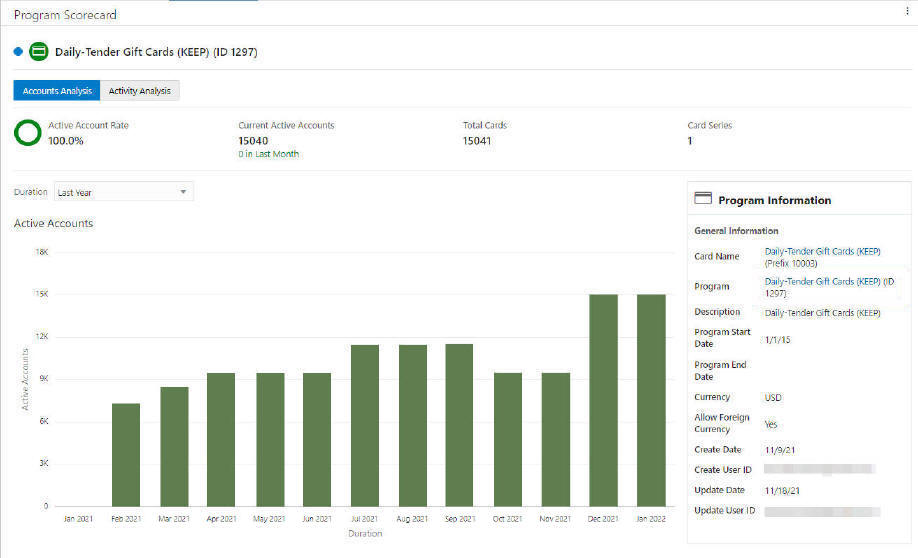
-
Activity Analysis
-
Issued Value LTD - The total value issued lifetime to date to all active account holders. This includes the activation amount, recharge amount and any amounts returned to the account.
-
Issued Value MTD - The total value issued month to date to all active account holders. This includes the activation amount, recharge amount and any amounts returned to the account.
-
Redeemed Value LTD - The total value redeemed lifetime to date for all active account holders. This includes the cash out amount, post authorize amount, redeemed amount and service charge amount.
-
Redeemed Value MTD - The total value redeemed month to date for all active account holders. This includes the cash out amount, post authorize amount, redeemed amount and service charge amount.
-
Outstanding Balance - The total value issued that has not yet been redeemed for all active account holders.
-
Average Balance Per Account - The average balance held on account for all active account holders. This is calculated by dividing the total outstanding balance divided by the total number of active accounts.
-
-
Activity Analysis Charts - Displays Last Year or Lifetime to Date analysis of the Tender.
Figure 10-76 Activity Analysis - Issued

-
Issued Value
-
Redeemed
-
Outstanding Balance
Note:
Hovering the mouse over any bar in the graph displays the information for that bar.
Figure 10-77 Chart Tooltip
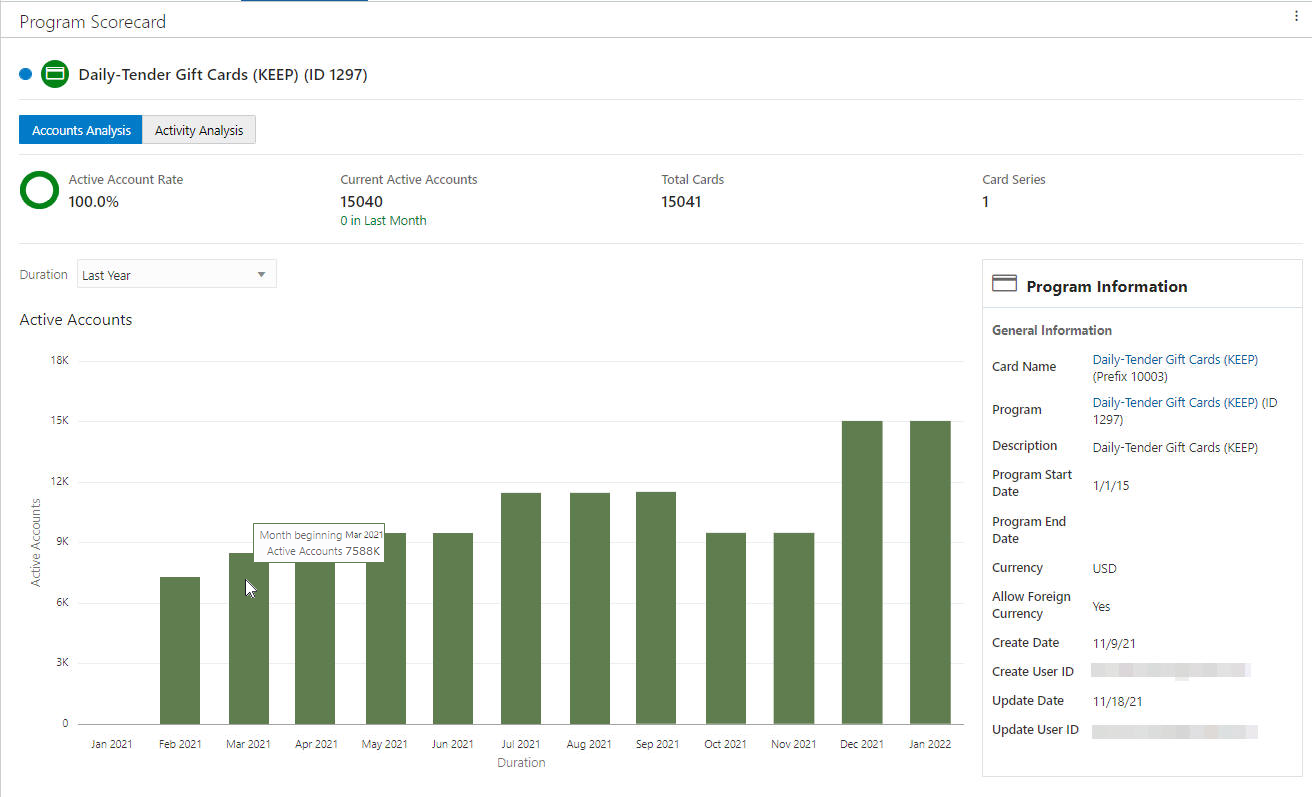
-
-
Program Information - (displays on all windows) Lists the General Information including:
-
Card Name - Click the link to open the View Card screen.
-
Program - Click the link to open the View Program screen.
-
Description
-
Program Start Date
-
Program End Date
-
Currency
-
Allow Foreign Currency
-
Create Date
-
Create User ID
-
Update Date
-
Update User ID
-
-
-
When finished viewing the Program Scorecard, click the X in the Program Title tab to close the window.
Viewing the Loyalty Program Scorecard
The Program Scorecard provides a snapshot of how a Loyalty Program is doing.
To access the Program Scorecard for analysis on a Loyalty Program, the user can select the Loyalty Program name link on either the Programs List or the Programs Advanced Search results windows.
To access the Programs List:
-
From the Main menu, click Tasks.
-
Click Program.
-
Click Program Home. This displays the Program Home tab which contains the Program List.
Note:
You will need the Program Home role in order to see this menu option.
Figure 10-78 Program Home

To access Program Advanced Search:
-
From the Main menu, click Tasks.
-
Click Program Search.
-
Enter criteria in the Search panel where you can search for a unique promotion, or click Search to retrieve all promotions.
Figure 10-79 Advanced Program Search

-
Select the link on a Loyalty Program Name, which then opens the Program Scorecard for that Loyalty Program.
Figure 10-80 Program Scorecard: Loyalty Program

-
The Program Scorecard window displays the following sections:
-
Title (displays on all windows) - Displays the Name and ID of the Loyalty Program as well as an indicator of whether the program is currently active or inactive (a solid Blue Dot represents an Active Program while an Empty Dot represents an Inactive Program).
Note:
When the aggregate job for a Program Scorecard has not yet run for the month, there is no column in the graph for the new month. A message appears to the right of the Name and ID of the Loyalty Program with the aggregate job identified to let you know why that column is not there, and shows you the job name so you can research the job if several days have gone by and the column is not appearing.
Note:
The Title section also displays a vertical ellipse. Click the vertical ellipse to either Edit or View the Program. See Editing Programs or Viewing Programs for more information.
Analysis Toggles - (chart displays on all windows) The following Analysis toggles are included for the Loyalty Program Scorecard:
-
Accounts Analysis
-
Customers in Program - The percentage of customers that are active members of the selected program. This includes both primary and secondary account holders.
-
Current Active Accounts - The total number of accounts currently active for the selected program.
-
Registered Accounts Total - The total number of accounts that are registered to customers and are not anonymous for the program.
-
Registered Accounts Percentage - The percentage of active accounts that are registered to customers compared to all accounts (registered plus anonymous) for the program.
-
-
Accounts Analysis Chart - Displays Last Year or Lifetime to Date analysis of the Active Accounts by using the Newly Registered or Total Registered toggles.
Figure 10-81 Accounts Analysis Chart
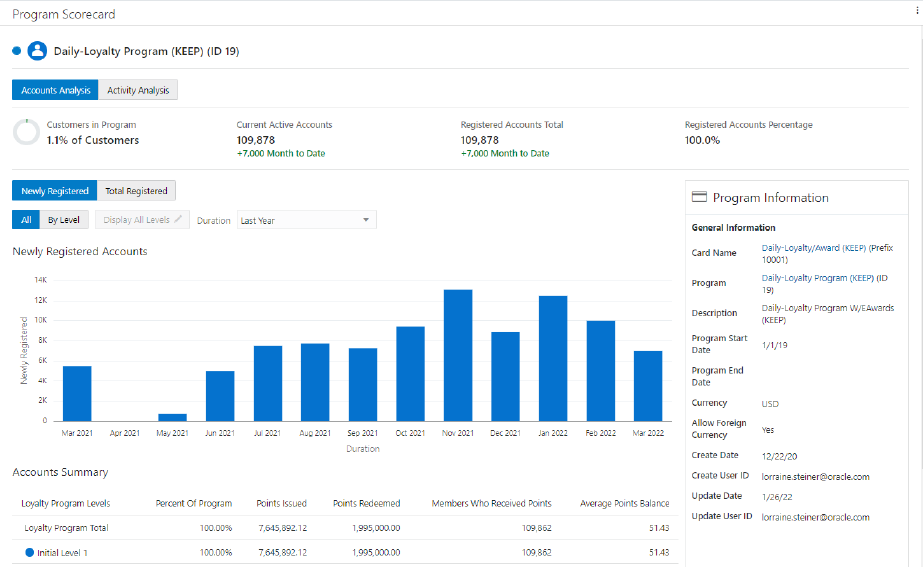
-
Newly Registered
-
All - Displays all levels.
-
By Level - Activates the Display All Levels button as shown in . Click to open the Filter Levels to Display window and select the desired levels. Click OK to confirm selections.
-
Duration - Used for all Newly Registered options and displays Last Year or Lifetime to Date information.
-
-
Total Registered
-
All - Displays all levels
-
By Level - Activates the Display All Levels button as shown in . Click to open the Filter Levels to Display window and select the desired levels. Click OK to confirm selections.
-
Duration - Used for all Total Registered options and displays Last Year or Lifetime to Date information
-
Note:
Hovering the mouse over any bar in the graph displays the information for that bar.
Figure 10-82 Chart Tooltip
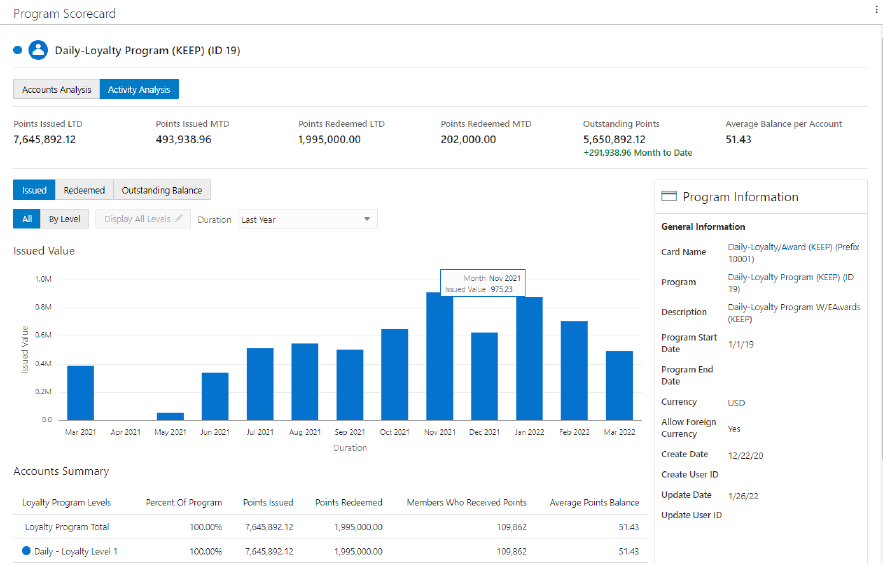
-
-
Activity Analysis
-
Points Issued LTD - The total number of lifetime to date points issued to all active account holders. This includes both earned and bonus points. Escrow points are excluded.
-
Points Issued MTD - The total number of month to date points issued to all active account holders. This includes both earned and bonus points. Escrow points are excluded.
-
Points Redeemed LTD - The total number of lifetime to date points redeemed by active account holders for the program.
-
Points Redeemed Month MTD - The total number of month to date points redeemed by active account holders for the program.
-
Outstanding Points - The total number of points issued that have not yet been redeemed. This includes both earned and bonus points. Escrow points are excluded.
-
Average Balance Per Account - The average points balance for all active accounts for the loyalty program. This includes both registered and anonymous account holders. This is calculated by dividing the total earned points balance by the total number of active accounts.
-
-
Activity Analysis Charts - Displays Last Year or Lifetime to Date analysis of the points by using the Issued, Redeemed, or Outstanding Balance toggles.
Figure 10-83 Activity Analysis Chart

-
Issued
-
All - Displays all levels
-
By Level - Activates the Display All Levels button as shown in . Click to open the Filter Levels to Display window and select the desired levels. Click OK to confirm selections.
-
Duration - Used for all Issued Value options and displays Last Year or Lifetime to Date information
-
-
Redeemed
-
All - Displays all levels
-
By Level - Activates the Display All Levels button as shown in . Click to open the Filter Levels to Display window and select the desired levels. Click OK to confirm selections.
-
Duration - Used for all Redeemed Value options and displays Last Year or Lifetime to Date information
-
-
Outstanding Balance
-
All - Displays all levels
-
By Level - Activates the Display All Levels button as shown in . Click to open the Filter Levels to Display window and select the desired levels. Click OK to confirm selections.
-
Duration - Used for all Outstanding E-Award Balance options and displays Last Year or Lifetime to Date information
-
Note:
Hovering the mouse over any bar in the graph displays the information for that bar.
Figure 10-84 Chart Tooltip

-
-
Accounts Summary - (displays on all windows) Summarized the following information:
-
Loyalty Program Levels - Lists the Loyalty Program Total and then lists each level created within that Loyalty Program
-
Percent of Program - The percentage of all active accounts in the loyalty program level compared to the entire program. This includes both registered and anonymous account holders.
-
Points Issued - The total number of lifetime to date points issued to all active account holders for the loyalty level. This includes both earned and bonus points. Escrow points are excluded.
-
Points Redeemed - The total number of lifetime to date points redeemed by active account holders for the loyalty level.
-
Members Who Received Points - The total number of unique customer ID’s associated with a points issue transaction for the loyalty program level. This includes both primary and secondary account holders.
-
Average Points Balance - The average points balance for all active accounts for the loyalty program level. This includes both registered and anonymous account holders. This is calculated by dividing the total earned points balance by the total number of active accounts.
-
-
Program Information - (displays on all windows) Lists the General Information including:
-
Card Name - Click the link to open the View Card screen.
-
Program - Click the link to open the View Program screen.
-
Description
-
Program Start Date
-
Program End Date
-
Currency
-
Allow Foreign Currency
-
Create Date
-
Create User ID
-
Update Date
-
Update User ID
-
-
-
When finished viewing the Program Scorecard, click the X in the Program Title tab to close the window.
Viewing the Award Program Scorecard
The Program Scorecard provides a snapshot of how an Award Program is doing.
To access the Program Scorecard for analysis on an Award Program, the user can select the Award Program name link on either the Programs List or the Programs Advanced Search results windows.
To access the Programs List:
-
From the Main menu, click Tasks.
-
Click Program.
-
Click Program Home. This displays the Program Home tab which contains the Program List.
Note:
You will need the Program Home role in order to see this menu option.
Figure 10-85 Program Home

To access Program Advanced Search:
-
From the Main menu, click Tasks.
-
Click Program Search.
-
Enter criteria in the Search panel where you can search for a unique promotion, or click Search to retrieve all promotions.
Figure 10-86 Advanced Program Search

-
Select the link on an Award Program Name, which then opens the Program Scorecard for that Award Program.
Figure 10-87 Program Scorecard: Award Program

-
The Program Scorecard window displays the following sections:
-
Title (displays on all windows) - Displays the Name and ID of the Award Program as well as an indicator of whether the program is currently active or inactive (a solid Blue Dot represents an Active Program while an Empty Dot represents an Inactive Program).
Note:
When the aggregate job for a Program Scorecard has not yet run for the month, there is no column in the graph for the new month. A message appears to the right of the Name and ID of the Award Program with the aggregate job identified to let you know why that column is not there, and shows you the job name so you can research the job if several days have gone by and the column is not appearing.
Note:
The Title section also displays a vertical ellipse. Click the vertical ellipse to either Edit or View the Program. See Editing Programs or Viewing Programs for more information.
-
Metrics (displays on all windows)
-
Redemption Rate LTD - The percentage of lifetime to date awards redeemed from those that have been issued.
-
Outstanding E-Award Value - The total value of e-awards available for redemption.
-
Customers in Program - The percentage of customers that are active members of the selected program out of all customers. This includes both primary and secondary account holders.
-
Current Active Accounts - The total number of active accounts. This includes registered and anonymous accounts.
-
Registered Accounts Total - The total number of accounts that are registered to customers and are not anonymous for the program.
-
Registered Accounts Percentage - The percentage of active accounts that are registered to customers compared to all accounts (registered plus anonymous) for the program.
-
-
Award Analysis Graphs
-
Issued
-
All - Plots all Issued Awards
-
Award Certificate - Plots only Issued Award Certificates
-
E-Award - Plots only Issued E-Awards
-
Duration - Used for all Issued Award options and displays Last Year or Lifetime to Date information
-
-
Redeemed
-
All - Plots all Redeemed Awards
-
Award Certificate - Plots only Redeemed Award Certificates
-
E-Award - Plots only Redeemed E-Awards
-
Duration - Used for all Redeemed Award options and displays Last Year or Lifetime to Date information
-
-
Outstanding Awards
-
All - Plots all Outstanding Awards
-
Award Certificate - Plots only Outstanding Award Certificates
-
E-Award - Plots only Outstanding E-Awards
-
Duration - Used for all Outstanding Award options and displays Last Year or Lifetime to Date information
-
-
Outstanding Balance - Graphs the outstanding E-Award balances by Last Year or Lifetime to Date durations
Note:
Hovering the mouse over any bar in the graph displays the information for that bar.
Figure 10-88 Chart Tooltip
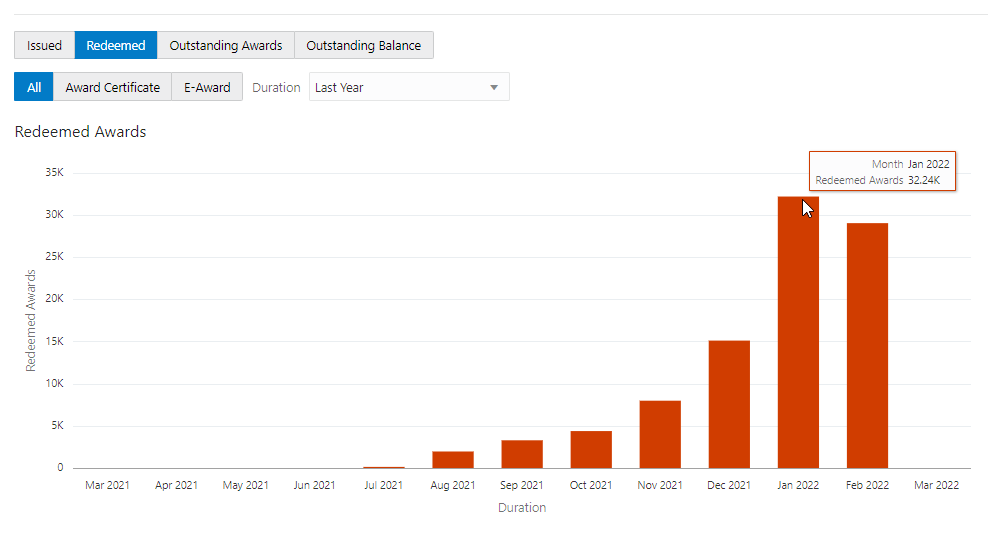
-
-
Program Information - (displays on all windows) Lists the General Information including:
-
Card Name - Click the link to open the View Card screen.
-
Program - Click the link to open the View Program screen.
-
Description
-
Program Start Date
-
Program End Date
-
Currency
-
Allow Foreign Currency
-
Create Date
-
Create User ID
-
Update Date
-
Update User ID
-
-
-
When finished viewing the Program Scorecard, click the X in the Program Title tab to close the window.